Luang Prabang World Heritage Site
In my last post I weighed the pros and cons of visiting Laos with Adventures Abroad and concluded that the pros far outweighed the cons. In this post I’ll begin zeroing in on the wonderful sights that await the visitor to this exotic country starting with the former royal capital and religious centre of Laos, Luang Prabang. Join our small group as we explore some of the many temples of this UNESCO World Heritage Site.
Chances are that most people have never heard of Luang Prabang and might wonder why Adventures Abroad chose it at the starting point for the Laotian tour. There’s a good reason for that. It is located in the northern part of the country and is the natural place to start a tour the will make its way south to Vientiane following the main north/south highway with a detour east to the Plain of Jars along the way. It has a small international airport which Alison and I arrived at on a direct flight from Bangkok.
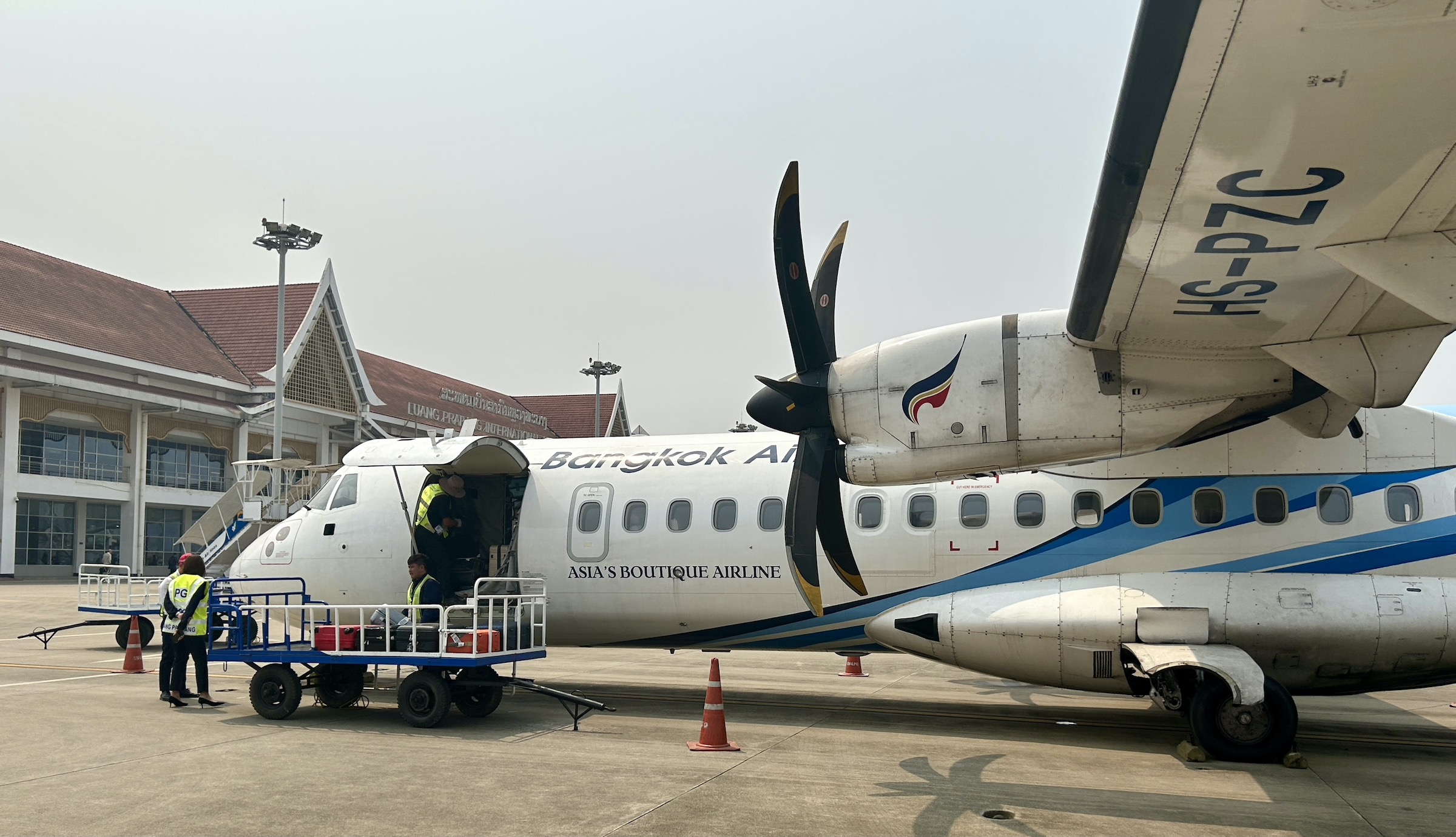
It also has some excellent hotels and restaurants so there is no reason to think you will be ‘roughing it’ while here. This is Le Palais Juliana where we spent three nights in very comfortable surroundings. I really enjoyed watching the fish in the pond beside the hotel from our balcony only a few feet away.
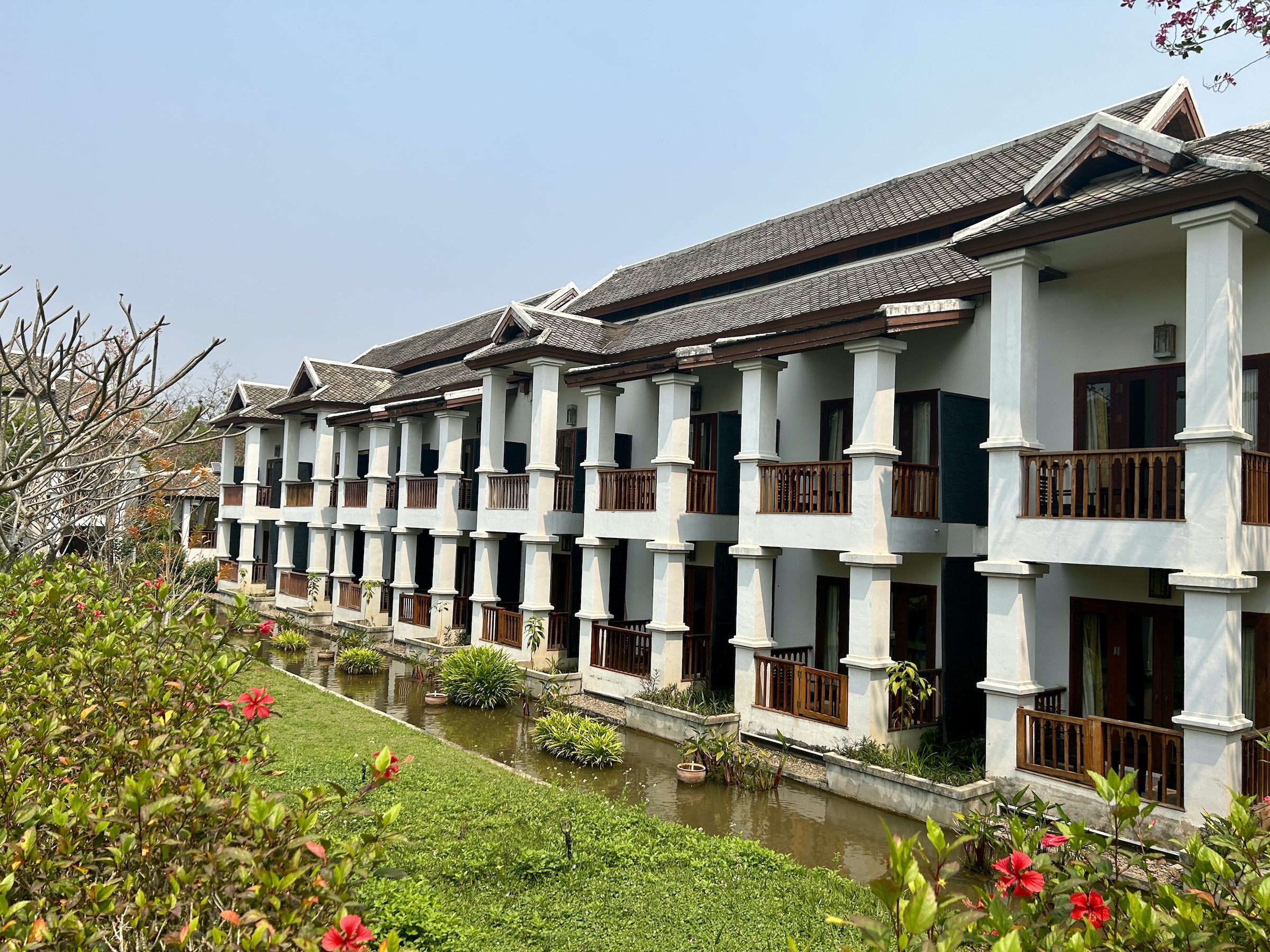
Others took advantage of the swimming pool to cool off after a hot day of exploring Luang Prabang or to just soak up the rays without getting wet.
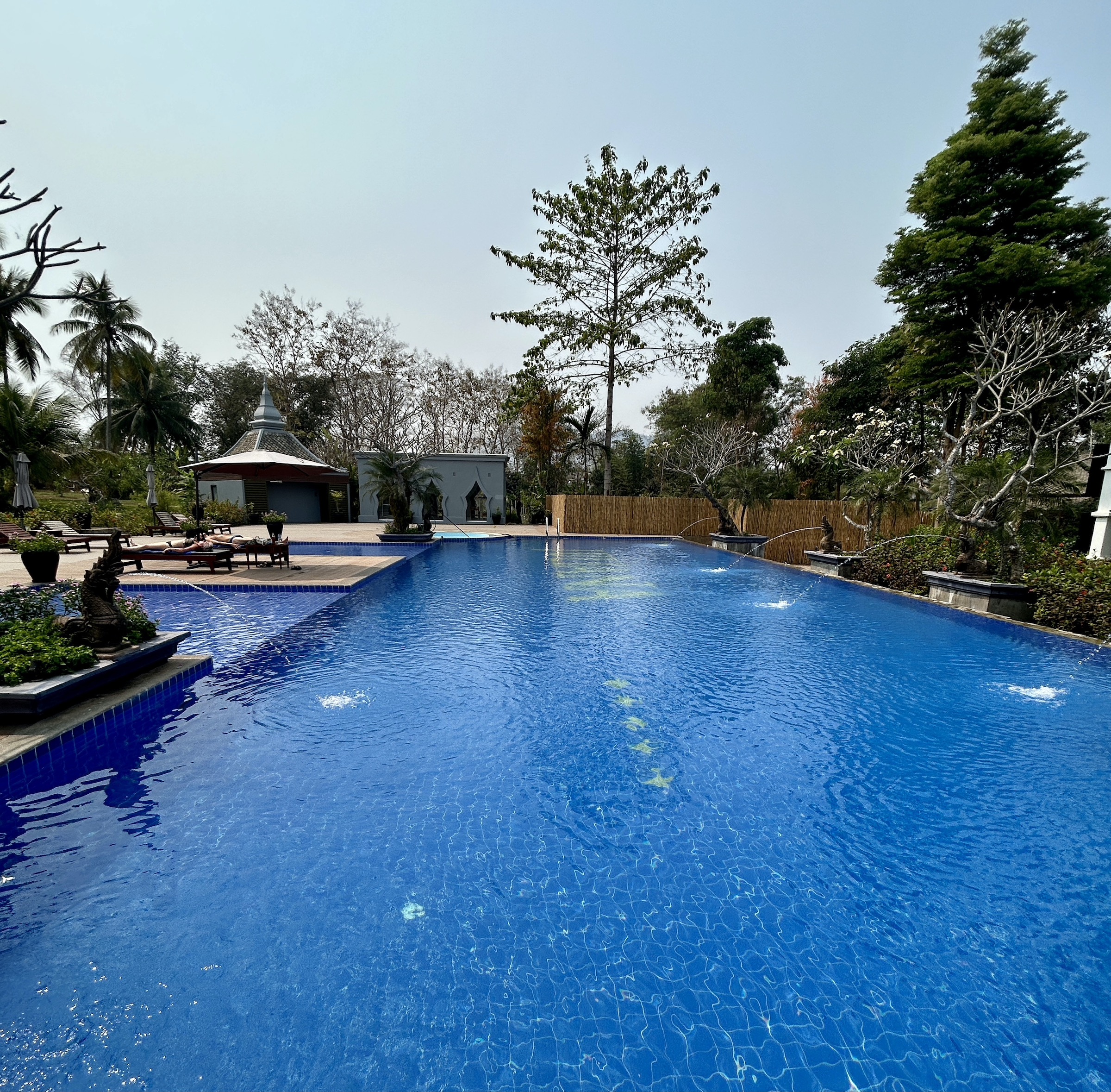
The breakfast buffet served in this room had a great selection of southeast Asian foods as well as western items. Personally I could eat noodles every morning and mostly did along with fresh fruit.
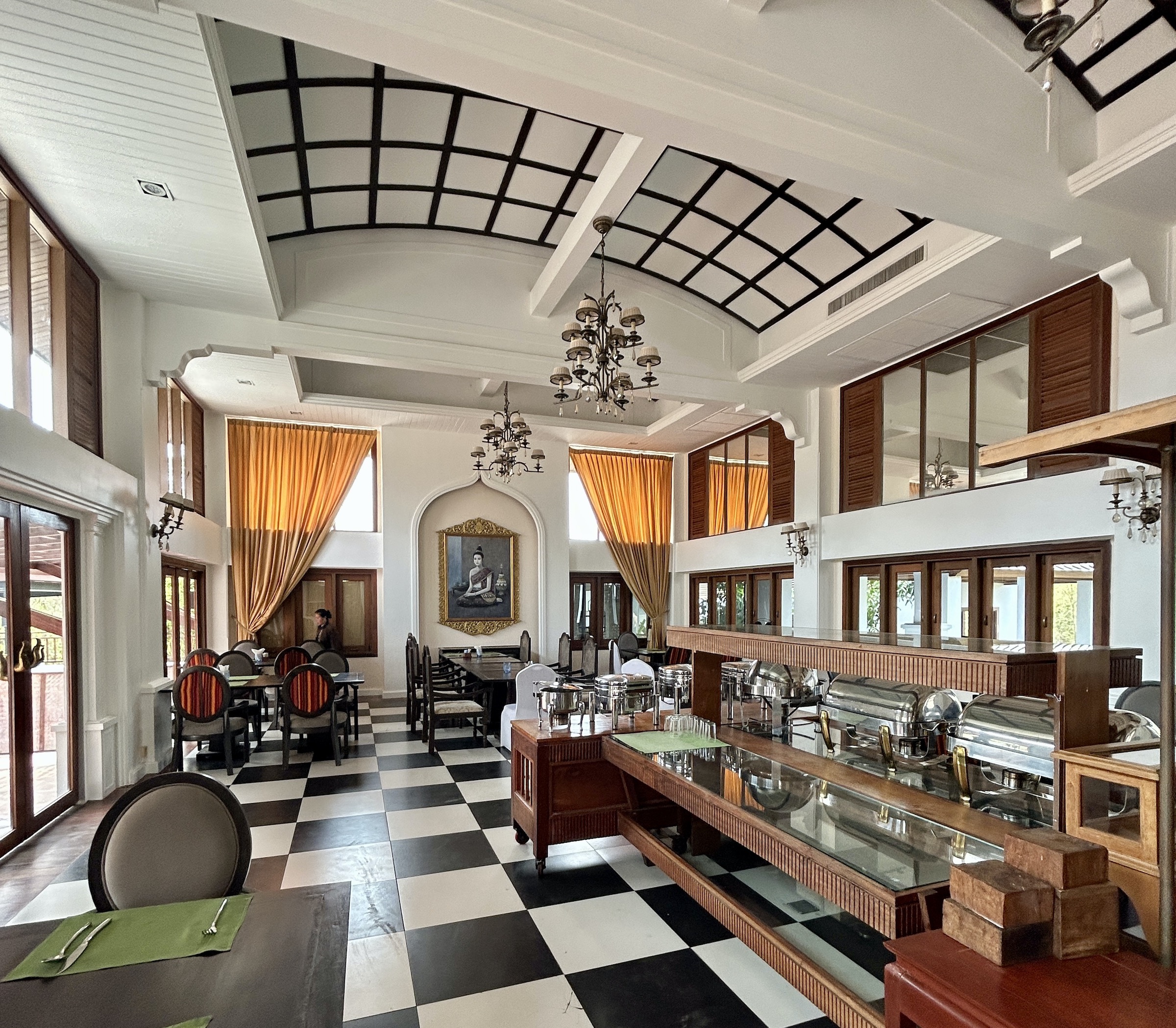
Now that were settled in let’s find out why Luang Prabang is a World Heritage Site
History of Luang Prabang
As I noted in the previous post on the history of Laos, the golden age of Laotian history was the Lan Xang period that lasted from 1353 to 1705, about the only one until modern times where the Laotians actually governed themselves. The capital of that kingdom was Xieng Thong which was later renamed Luang Prabang which literally means ‘Royal Buddha Image’. This came about as the result of the gift of a sacred Buddha image, the Phra Bang being gifted to the first king of Lan Xang by his father-in-law, the king of the Khmer nation based in Angkor, modern day Cambodia. The Phra Bang is the palladium of Laos which bestowed legitimacy to both the monarchy and the Buddhist religion in the country. The Thais stole it on a number of occasions, but returned it after it was blamed for causing problems in Siam after its removal there. Today it is housed in the Royal Chapel on the grounds of the former Royal Palace.
After the arrival of the Phra Bang, Luang Prabang became the undisputed religious centre of Laos and until 1975 the seat of the Laotian monarchy. It is home to a thirty-three Buddhist temples, most of which also have monks living on the premises. It was this collection of religious architecture along with the French colonial buildings of the early 1900’s that got Luang Prabang its UNESCO World Heritage Site designation which reads as follows:
Luang Prabang is an outstanding example of the fusion of traditional architecture and Lao urban structures with those built by the European colonial authorities in the 19th and 20th centuries. Its unique, remarkably well-preserved townscape illustrates a key stage in the blending of these two distinct cultural traditions.
On top of this Luang Prabang has a beautiful location on a peninsula created by the confluence of the Mekong and Nam Khan rivers with a steep hill rising in the middle to a height of 490 feet (150 metres). It is not a large city with only 24,000 residents in the historic part of the city and 56,000 overall.
Haw Pha Bang and the Royal Palace
Let’s begin our tour of the Luang Prabang Buddhist sites by going right to the most important one first, the Haw Pha Bang temple on the grounds of the former Royal Palace where the Phra Bang is kept. At the hotel we meet our local guide who goes by the simple name of just Ta. He will be with us for the entire time we are in Laos. It’s a short ride from the hotel to the historic district and from there we walk from place to place on foot.
This is the Haw Pha Bang which was built specifically to house the Phra Bang and only completed in 2006. Work started in 1963 but was halted due to the civil war and only restarted in the 1990’s. It is on the grounds of the former Royal Palace which is now designated as the National Museum. Photography is not permitted anywhere inside this complex with just a few exceptions. This is a public domain photograph sans the many Chinese tourists that were there during our visit.
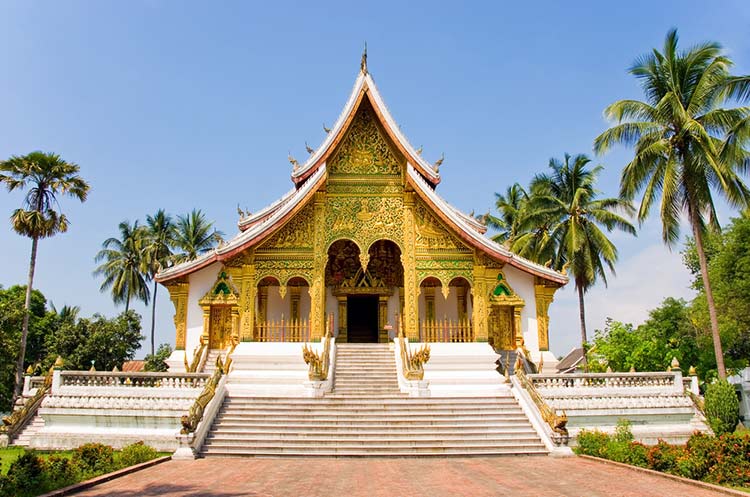
It is a stunning looking building and only gets better as you get closer.
These are two golden snake like creatures known as nagas which have been revered in Hinduism and Buddhism for well over 2,000 years. Unlike the bad reputation of serpents in Christianity, nagas are guardian figures preventing evil spirits to enter sacred places like Haw Pha Bang.
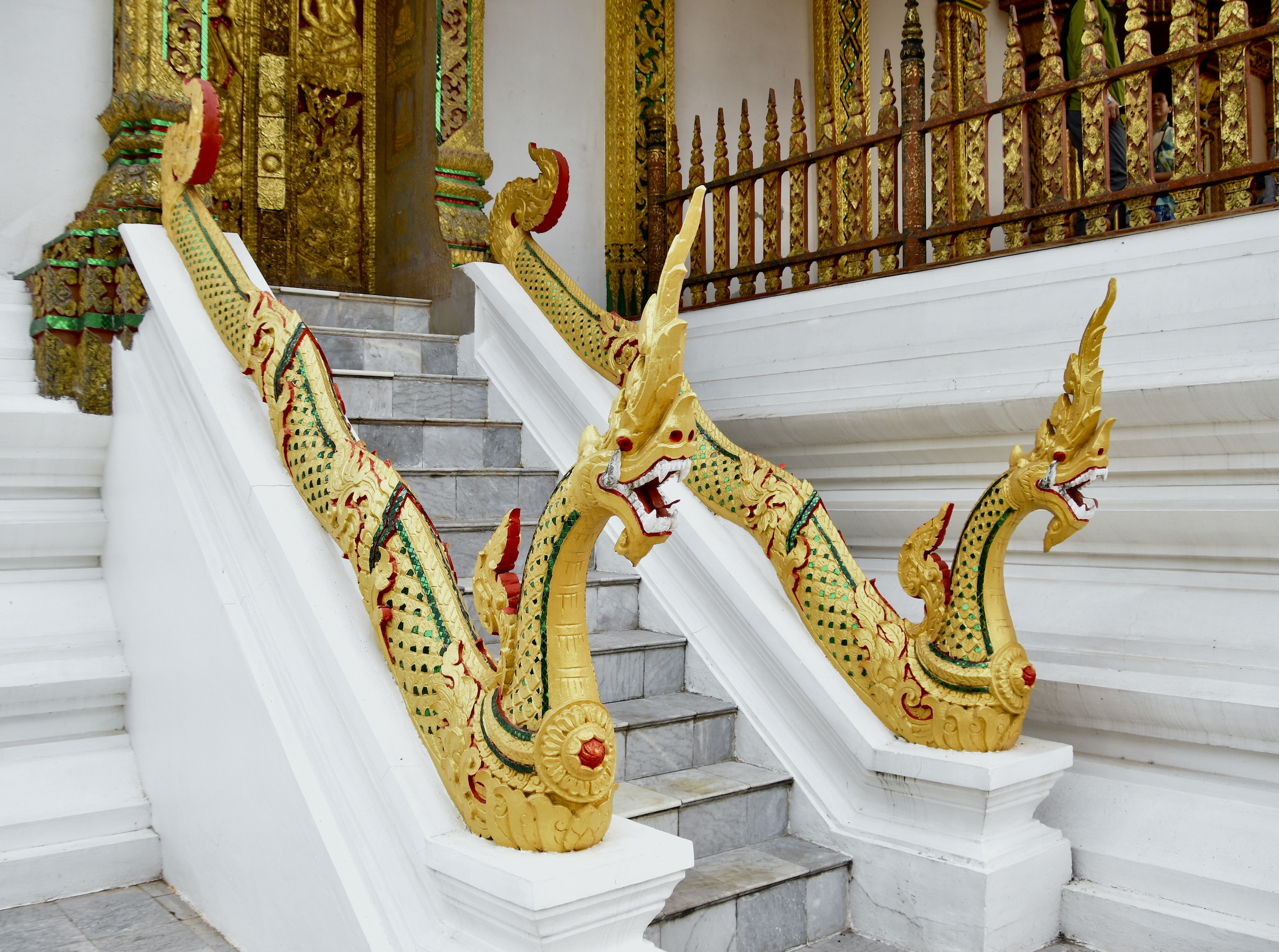
Just to make doubly sure of the job the main stairway is guarded by two seven-headed nagas. The similarity to the Greek hydra slain by Hercules is not lost on me.
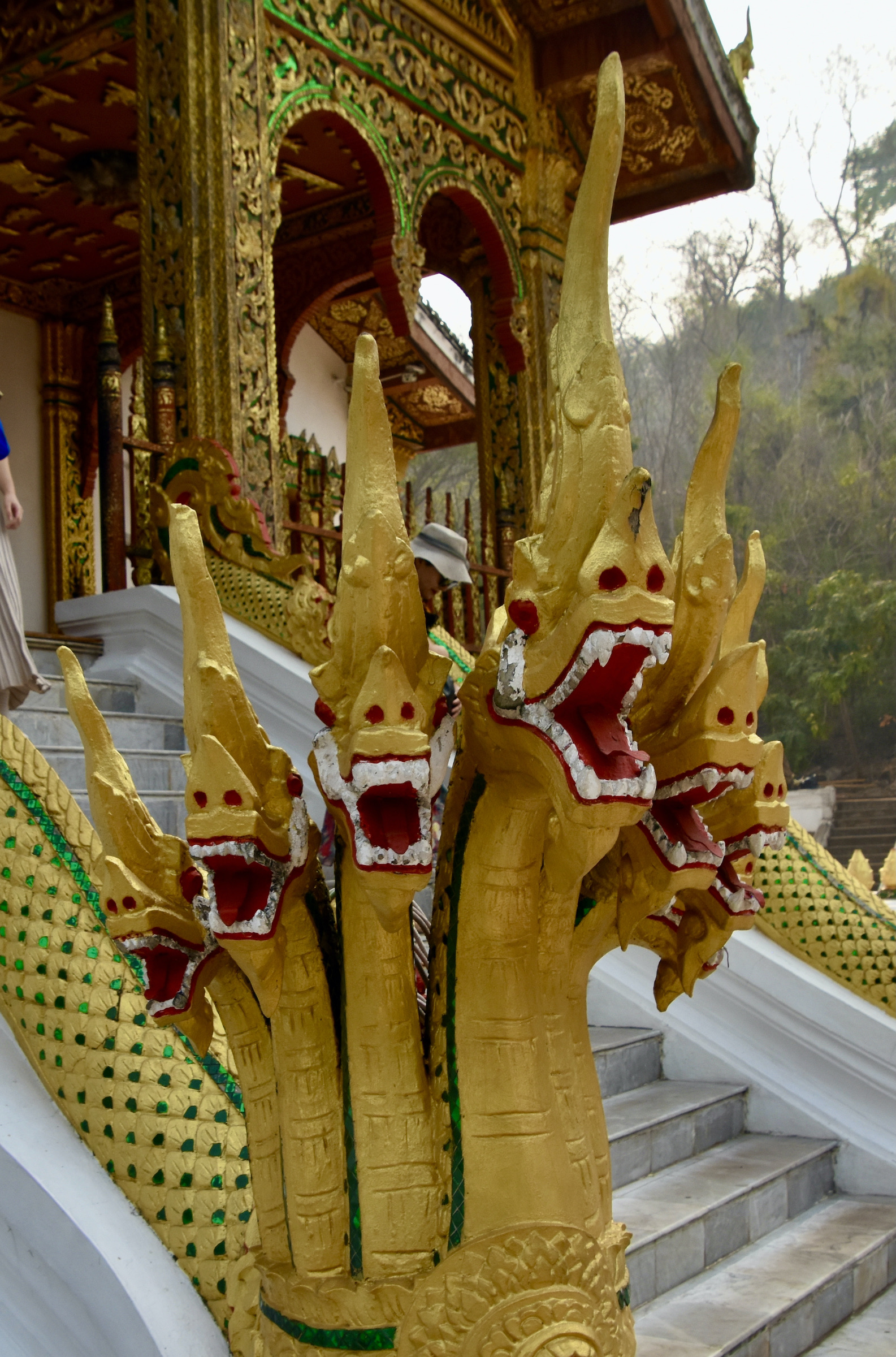
We then climb the stairs and enter Haw Pha Bang. To be honest I wish I had done more homework before embarking on this trip as I might have had a better appreciation of what I was about to see inside. As noted, the Phra Bang is the most important Buddha figure in Laos, but you wouldn’t know that just by looking at it. It’s less than three feet tall and not that much different from hundreds of other Buddhas we’ll see on this trip. However, it is composed of a rare alloy of gold, silver and bronze, originally said to have been made in Sri Lanka, but now believed to have been cast in the Khmer kingdom. Finding a public domain picture of it is not easy. The best I could do is this Laotian stamp.
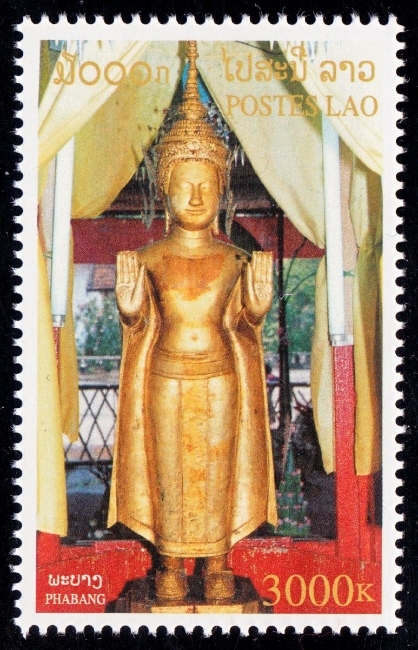
After viewing the Phra Bang we spent some more time in the Royal Palace grounds. This is the former palace, now the National Museum of Luang Prabang. Built only in 1904 by the French to house King Sisavang Vong it was taken over by the communists in 1975 and the monarchy abolished. If you look at the top of the entrance you will see the former symbol of the Laotian monarchy, three elephants under an umbrella. It used to be on the Laotian national flag until replaced by a white dot which stands for God knows what.
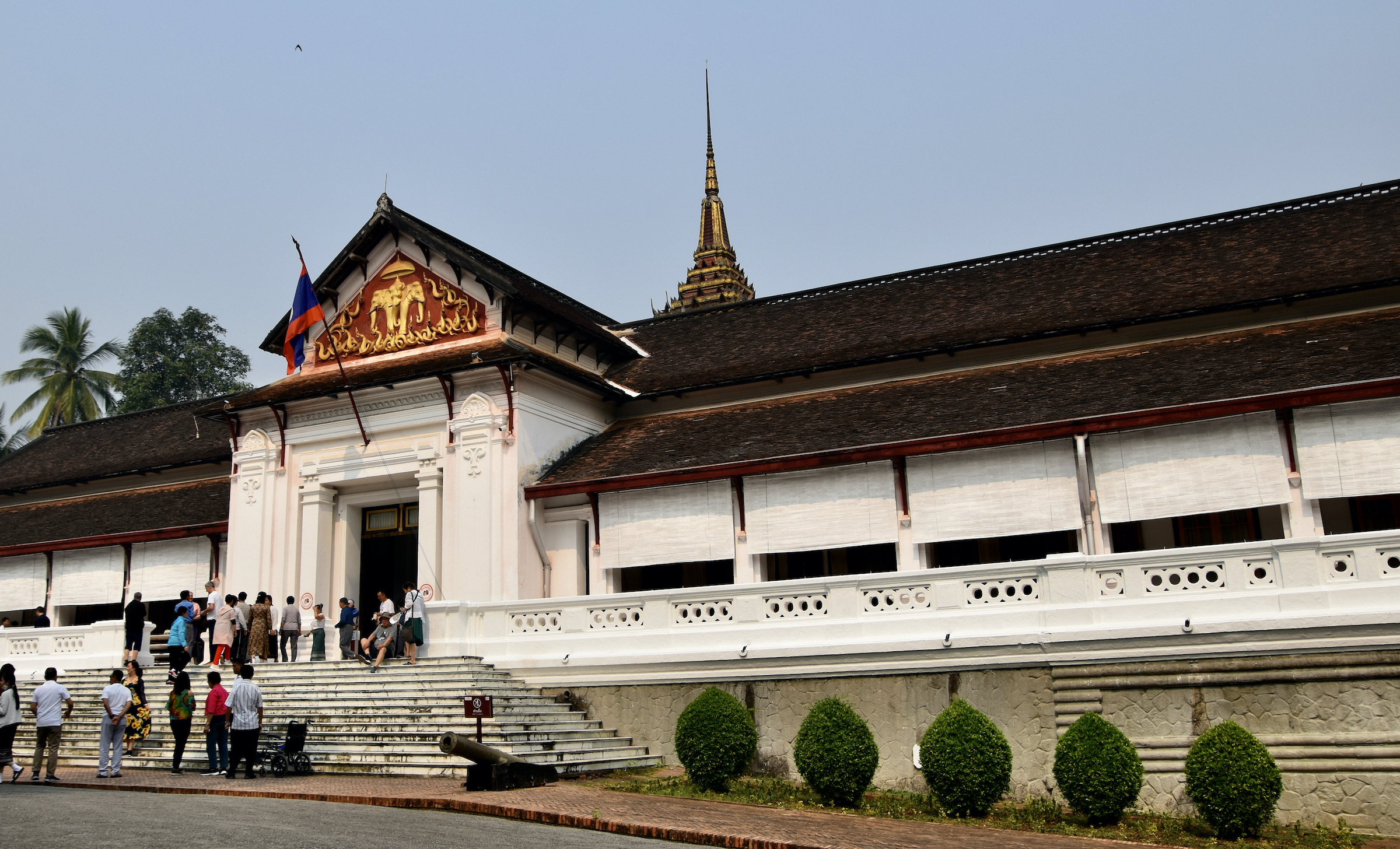
Looking around I see this symbol in a number of places. Typically the elephants are depicted as white, not gold such as over the door to the Royal Palace. For us white elephants are things of no great use, burdens rather than assets. For the people of southeast Asia white elephants are a symbol of kingship and today the Thai and Myanmar governments still keep a number of them. Believe it or not wars have been fought over control of white elephants.
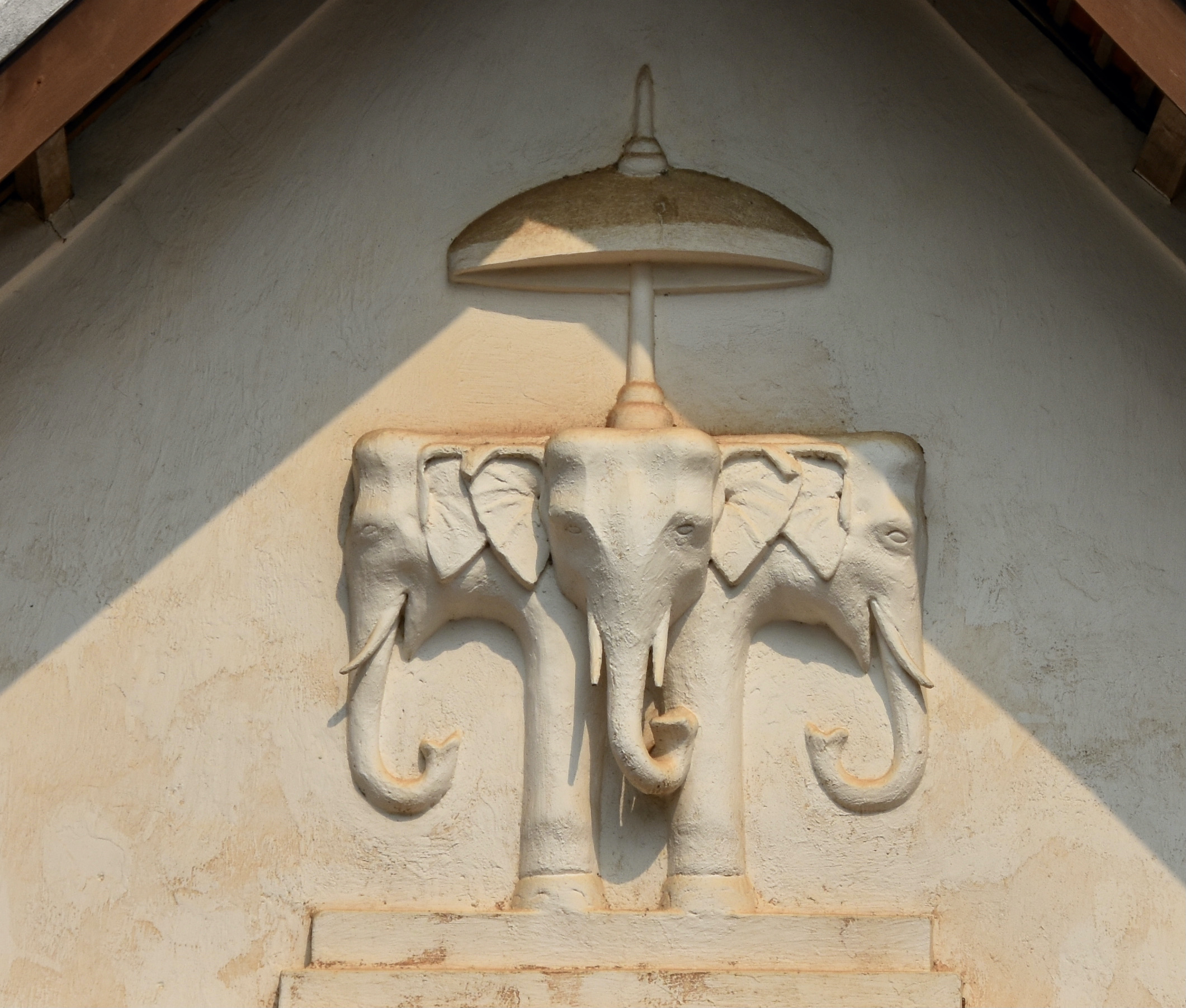
There is no photography in the museum and truth be told I was not struck by anything in particular that we saw inside. The small collection of the king’s former automobiles was more noteworthy, but again, no photos allowed.
Despite abolishing the monarchy the current communist government has not removed the statue of King Sisavang Vong and you can take a picture of it. I couldn’t help but think of North Korea’s dear leader Kim Jong Un when looking at it.

Wat Mai – the Royal Temple of Luang Prabang
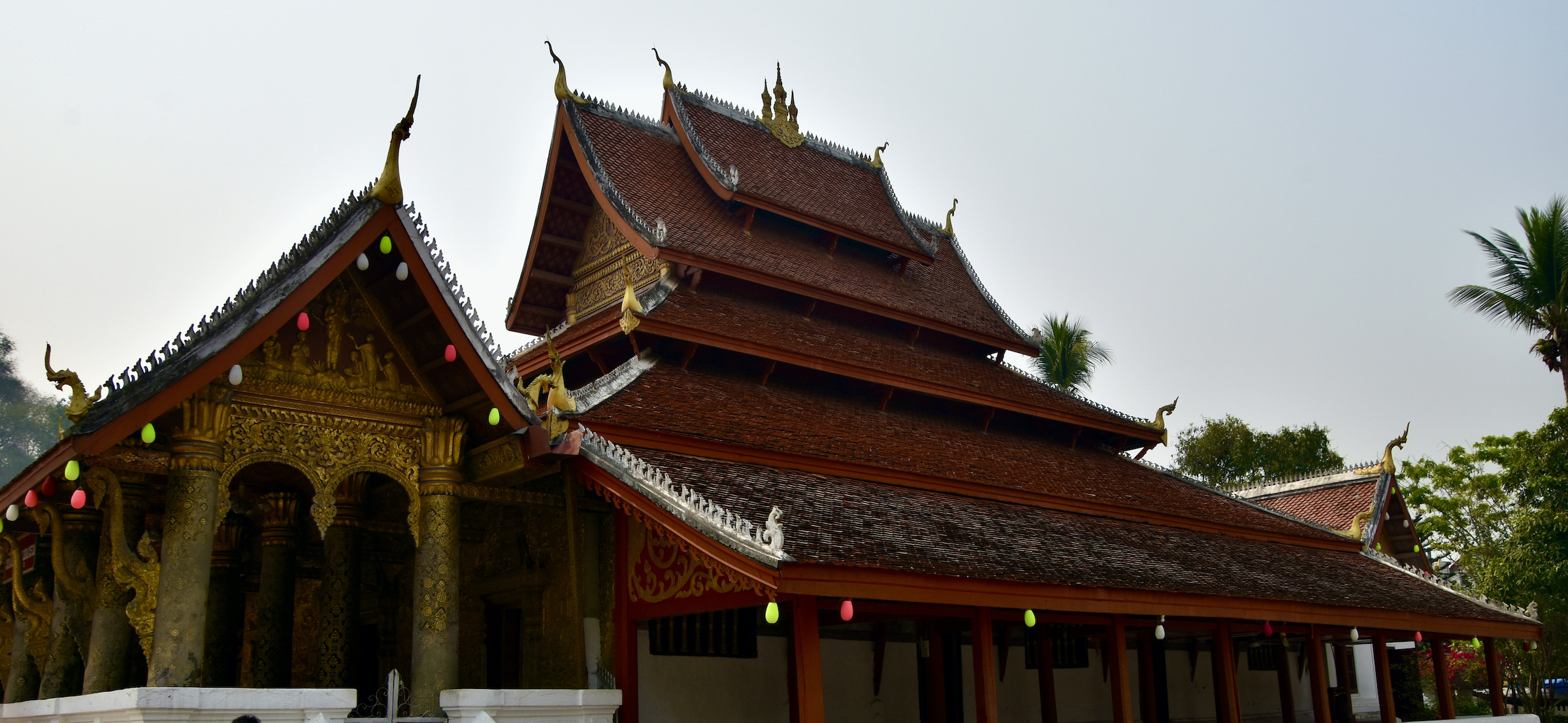
We now walked a short distance from the Haw Pha Bang to another temple which housed the Phra Bang Buddha until the newer building was completed. This is Wat Mai which somewhat confusingly translates as the New Monastery. It is also referred to as the Royal Temple as this was where the royal family worshipped. It dates mostly from the early 19th century although work on it started in the 18th century. Like gothic cathedrals it seems these Buddhist temples take some time to build and there’s a lot of tinkering that goes on over the years.
The entrance doors are works of art in themselves. They depict scenes from the Ramayana similar to those that Alison and I saw at the Royal Palace in Bangkok.
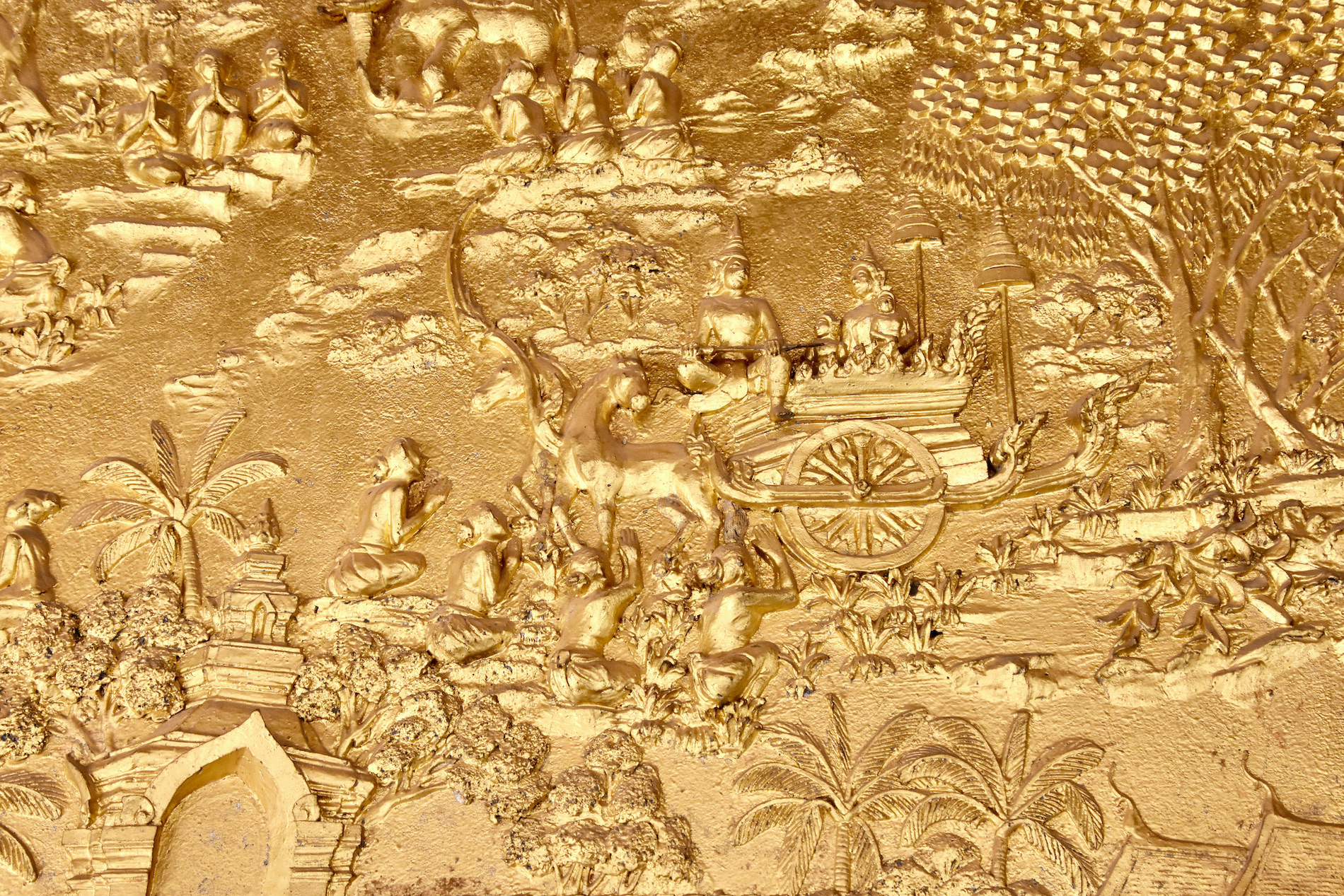
The inside is equally impressive with this huge meditating Buddha dominating the red panelled nave.
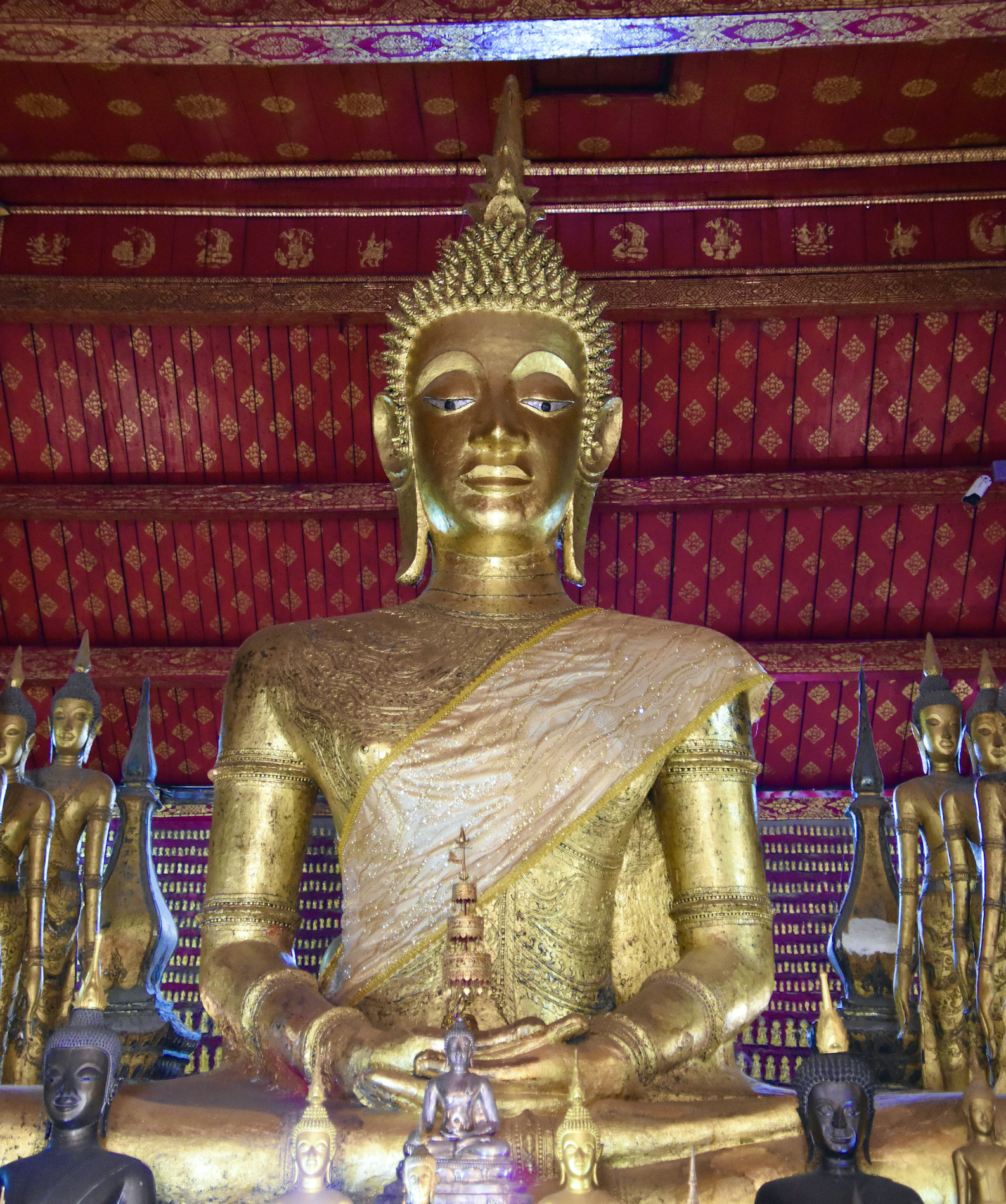
This is also the first time Ta points out something that will become commonplace in our visits to Buddhist temples throughout southeast Asia. This is a fortune telling device known as Kau chim or fortune sticks which originated in China, but is now prevalent at the altars of Buddhist temples. I won’t try to explain it, but follow the link to find out how it supposedly works.
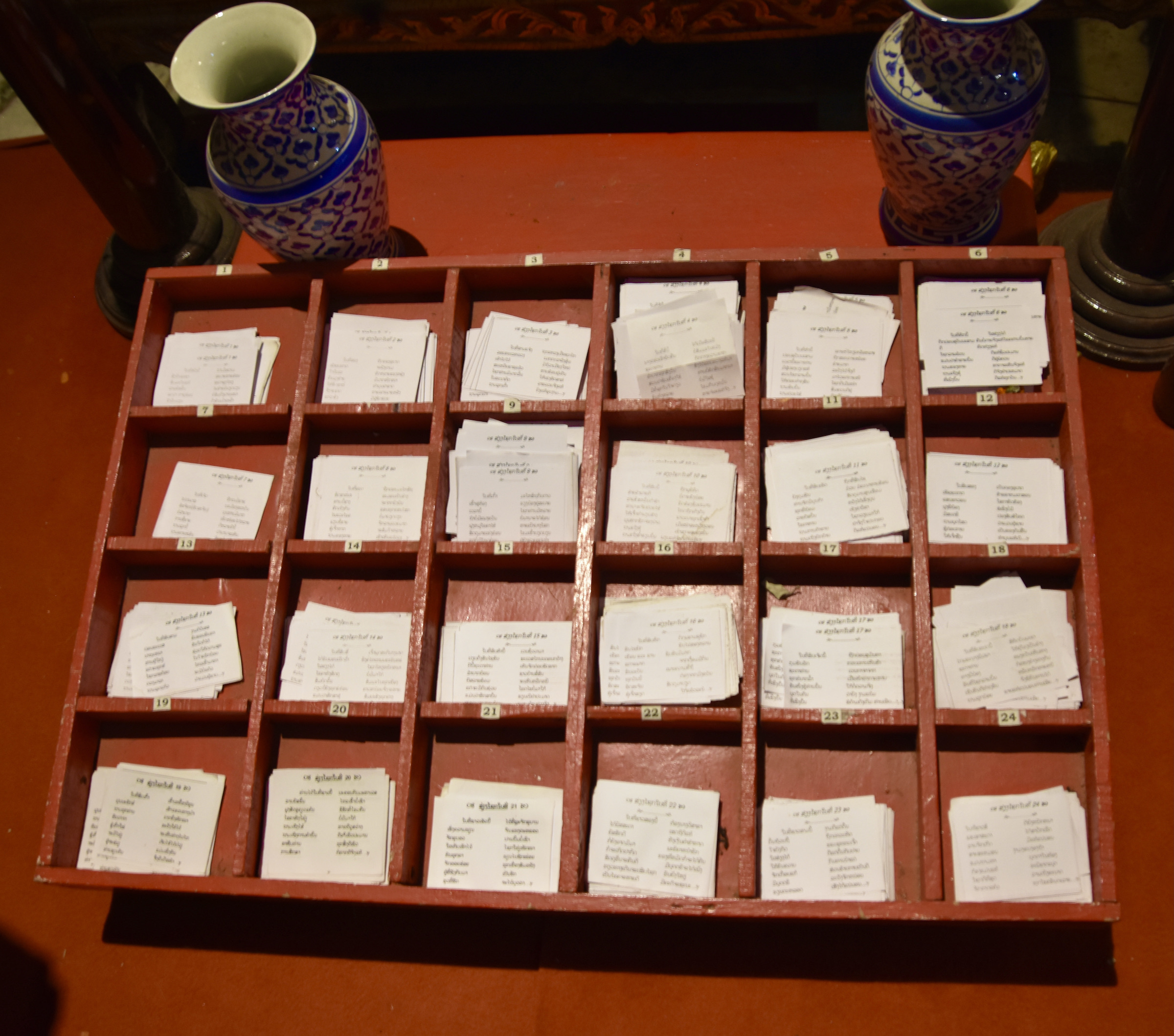
Wat Mai is notable not only for its architecture, but also as the residence of the Pra Sanghkarat, the highest ranking Buddhist in Laos, equivalent to the Supreme Patriarch of Thailand. We saw many monks going about their business while walking the grounds of the monastery, but I refrained from photographing them. I did photograph these three Buddhas in front of the many monastery buildings at Wat Mai.
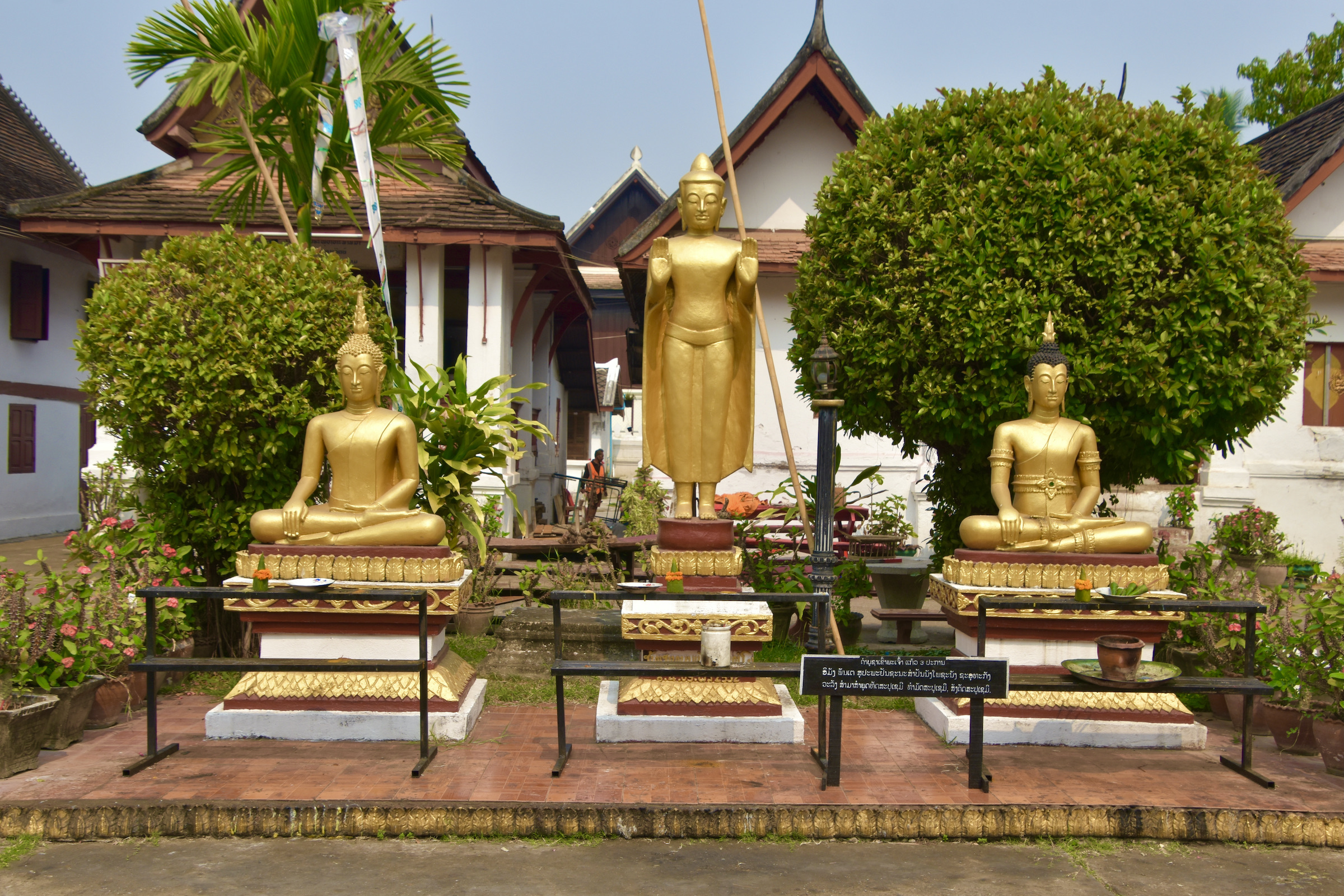
Moving on from Wat Mai our group walked by one of the staircases leading up to Mount Phou Si the high point on the Luang Prabang peninsula. It is considered to be a sacred mountain and by far the best place to get a look at the historic part of the city and the meeting of the two rivers. Going up the 300 steps to the top was not on the itinerary, but we had time to do it during our two days in Luang Prabang and my one regret from that place was not going up. I had reasons at the time, mostly related to the heat and the smoke filled air I mentioned in the last post, but in retrospect those were not good enough. So if you are reading this in anticipation of a future AA trip to Laos, don’t pass it up.
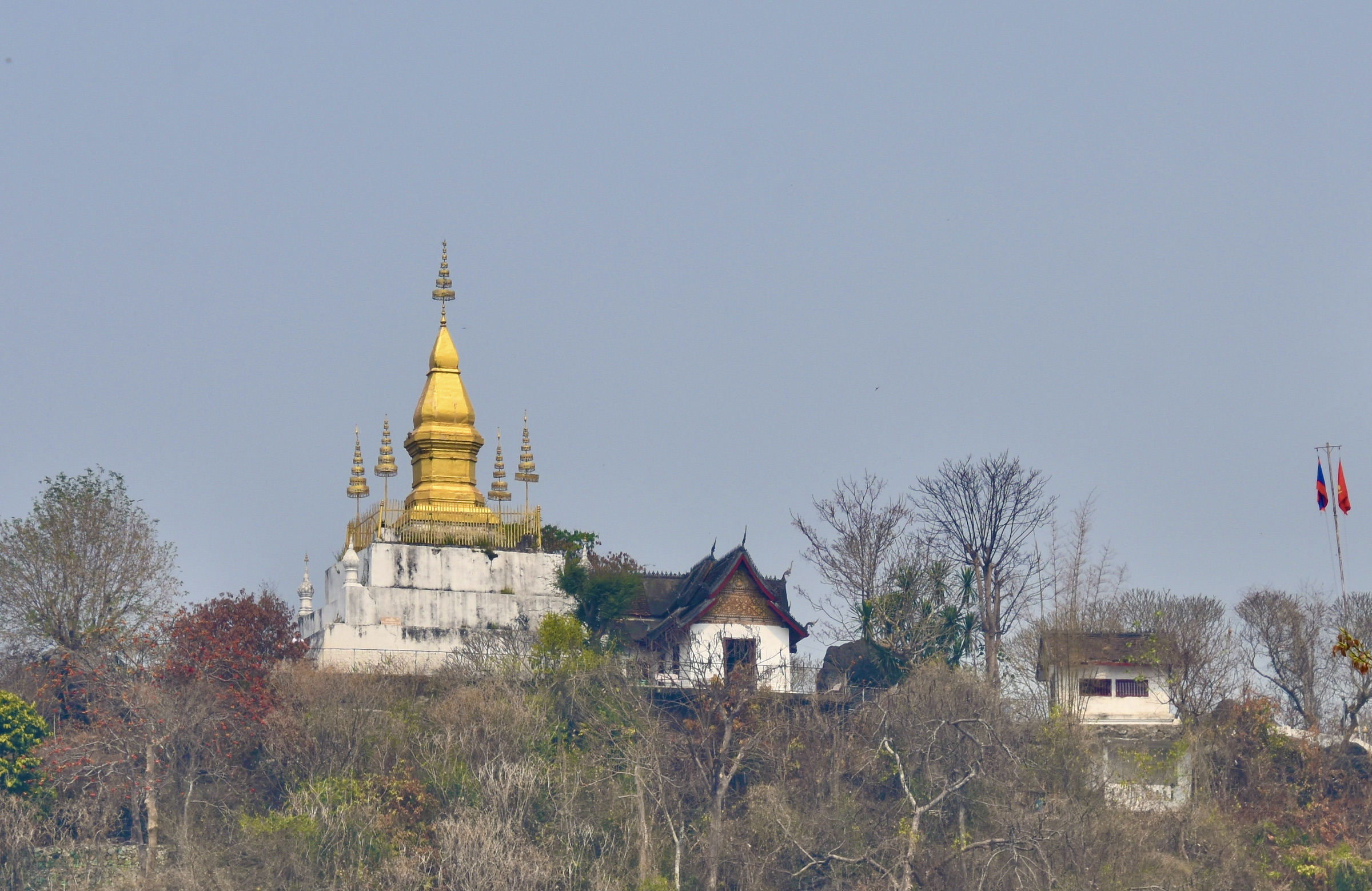
Wat Visounnarath
Our next stop was at the oldest temple in Luang Prabang, Wat Visounnarath, named for the king of the same name who had the temple and famous stupa built in 1512 during the heyday of the Lan Xang dynasty. Both buildings were looted and destroyed by Chinese gangs in 1887 and not rebuilt until the 1920’s.
The most imposing sight on the grounds is That Mak Mo aka the Watermelon Stupa. Stupas date back to the earliest days of Buddhism and the first ones were repositories for some the ashes of the Buddha, all in India. In time and as the amount of ashes attributable to the Buddha were depleted they became general reliquaries for items associated with not only Buddha, but other prominent Buddhist figures. We will be seeing a lot of these over the coming weeks.
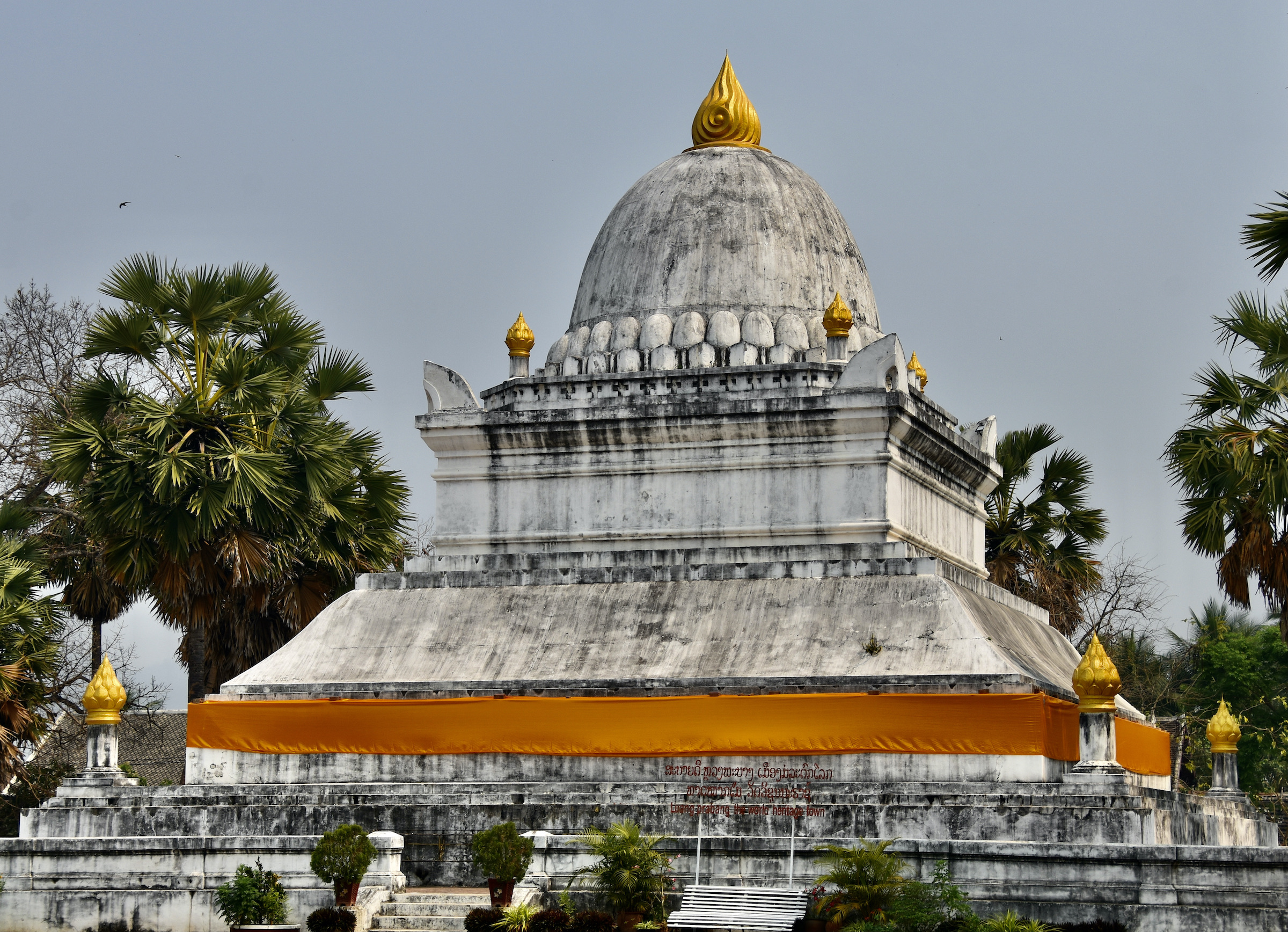
The temple at Wat Vissounarath contains a number of very interesting Buddhas. By now I’m starting to realize that there seems to be a hierarchy at work here with on large Buddha surrounded by progressively smaller ones.
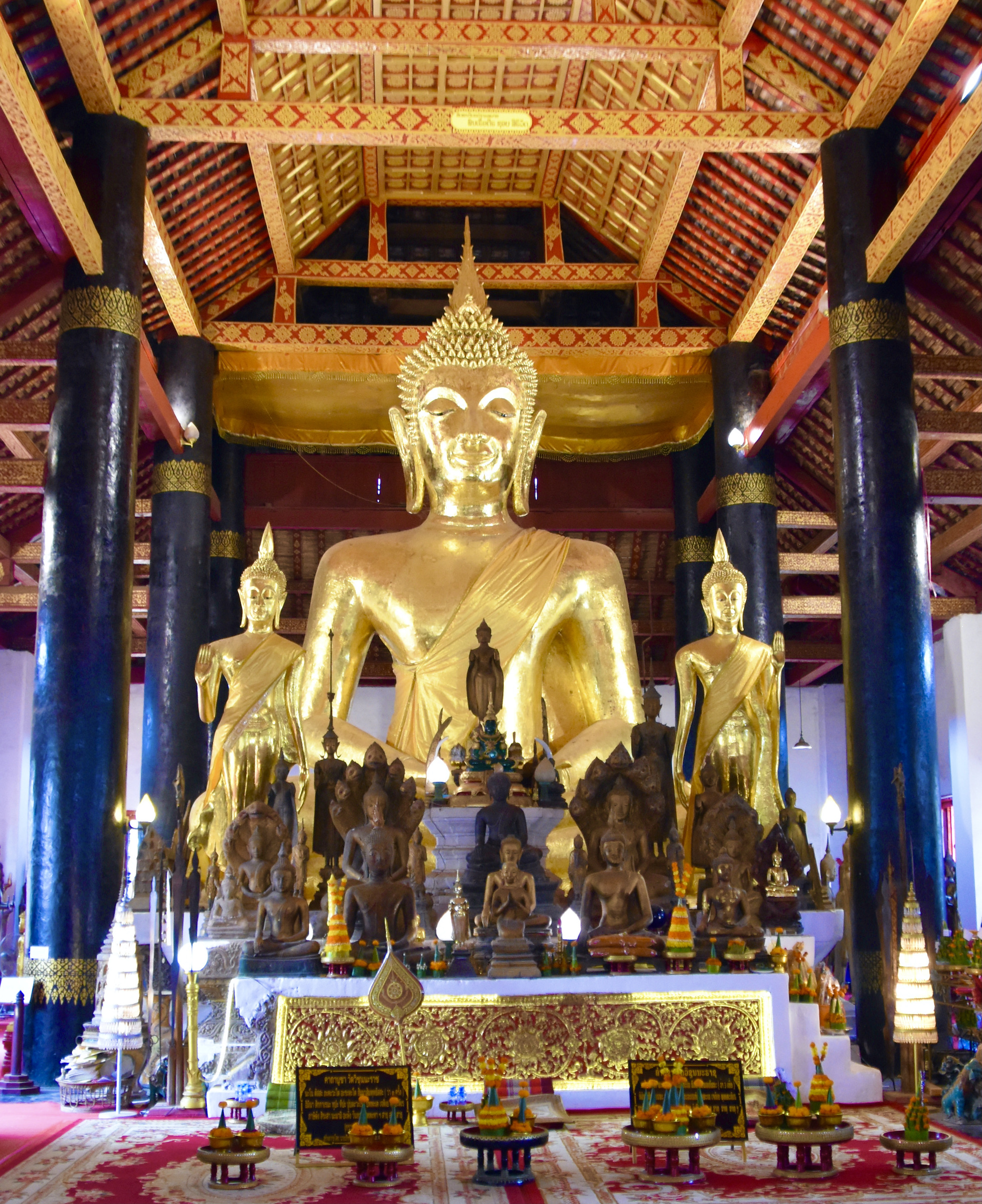
I’m also starting to notice a difference in the style of the Buddhas. Our tour guide Claude points these out to us as we make our way around the temple. This for example is a Khmer style statue notable for the broad flat nose and thick lips.
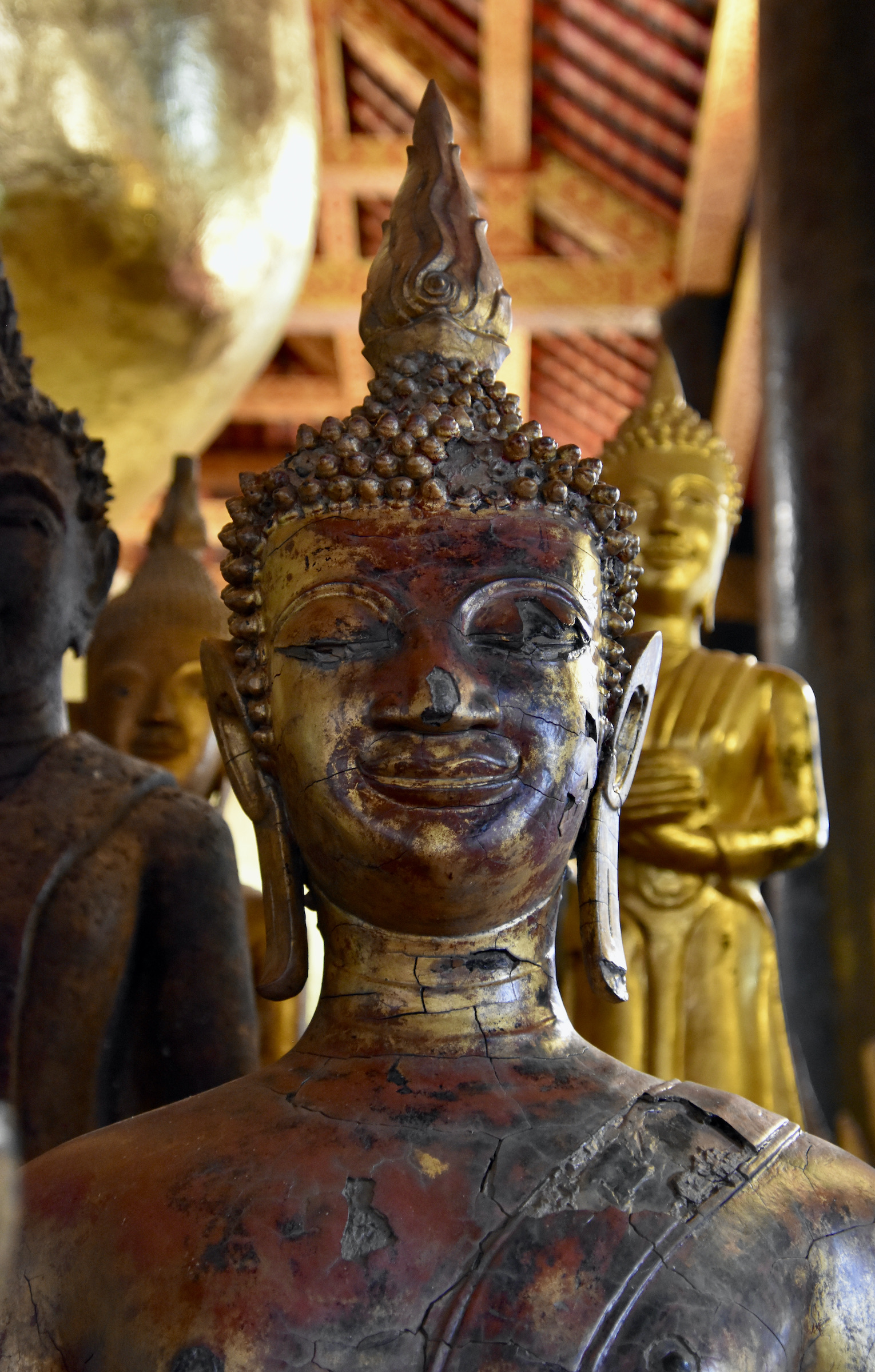
There are also Buddhas for specific purposes based on their various poses and stances. These Buddhas are in the ‘Call for Rain’ posture which apparently are found only in Laos. I’m hoping they don’t work during our stay in Luang Prabang.
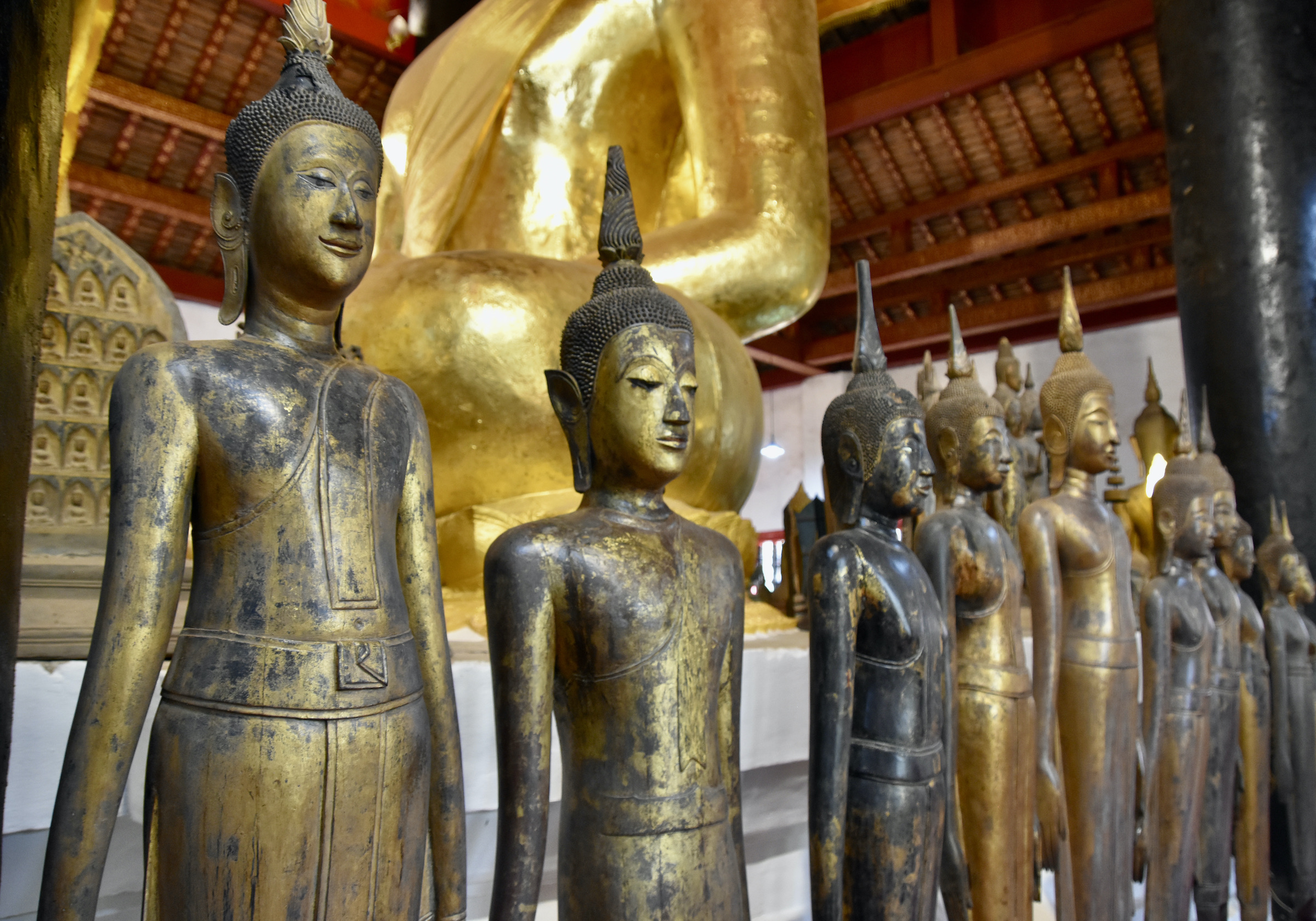
Leaving Wat Vissounarath we come across another commonly depicted scene in this monument in front of a large ficus tree. It symbolizes the Buddha meditating under the Bodhi Tree where he attained enlightenment, but not before the demon Mara and his army did all they could to prevent that from happening. All the other gods abandoned him in terror, but one. The earth goddess Thorani answered Buddha’s call and wrung water out of her hair as depicted below to drown Mara and let Buddha complete his final transition to nirvana. Once you are told the meaning of these things as we were by Claude and Ta, you get a much better appreciation of why they are where they are – in this case the ficus tree was a natural place to create this monument. As I mentioned in some of my posts from Thailand, getting an understanding of Buddhism and its relationship to Hinduism takes some effort, but is worth it in understanding the way of life in a place like Luang Prabang where religion is a major part of everyday life.
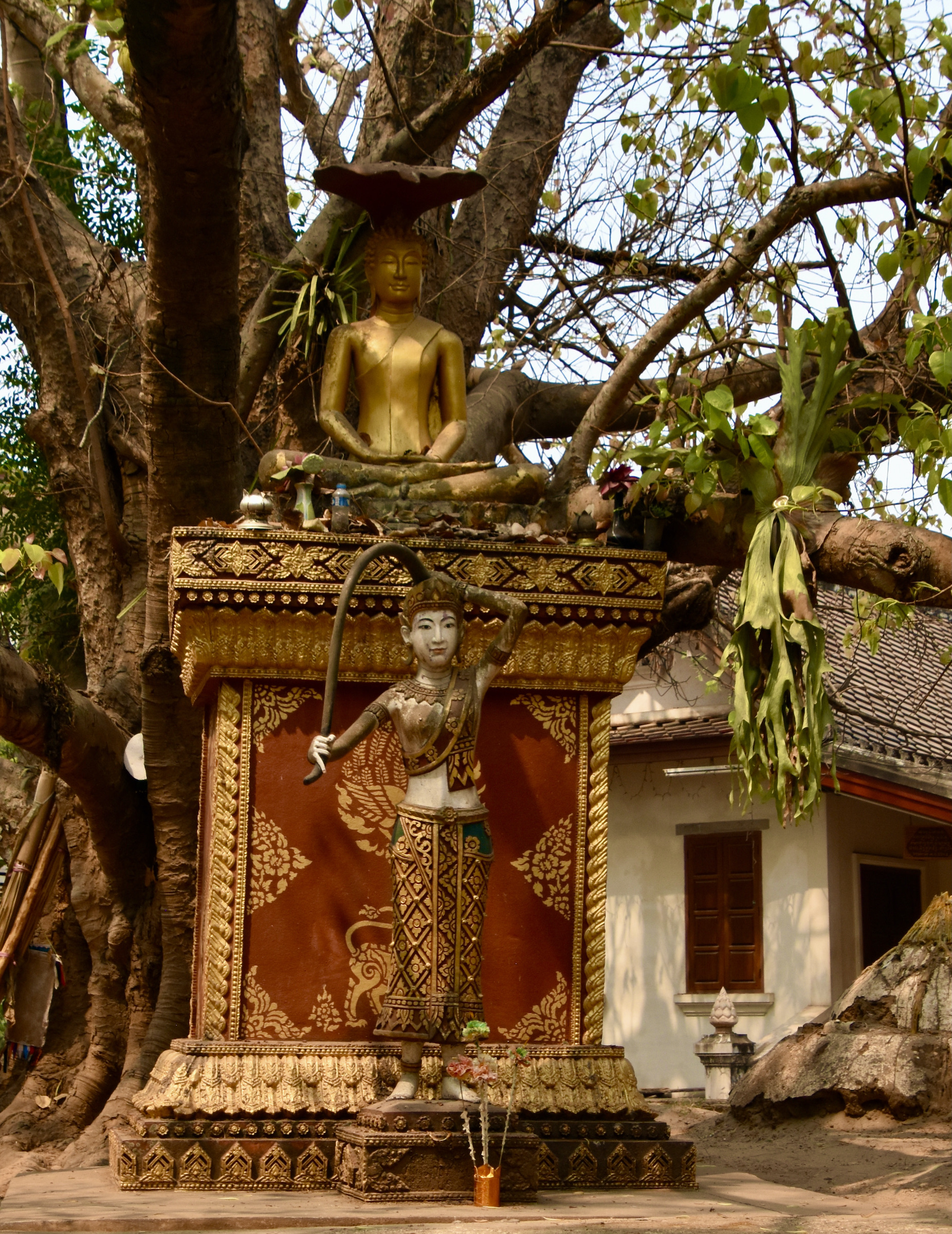
By now we were getting ‘templed out’ and stopped for lunch before visiting our final temple in Luang Prabang. Lunch is usually on your own on AA tours and Alison and I stopped at a place called Zurich Bread Factory and Cafe which is actually a southeast Asian chain specializing in western style sandwiches. First I grabbed a local Luang Prabang craft beer specifically brewed to pair well with the cuisine of the city. In addition to the usual ingredients of malted barley and hops this beer has rice as well. I can’t say that I noticed any marked difference from lagers made without rice.
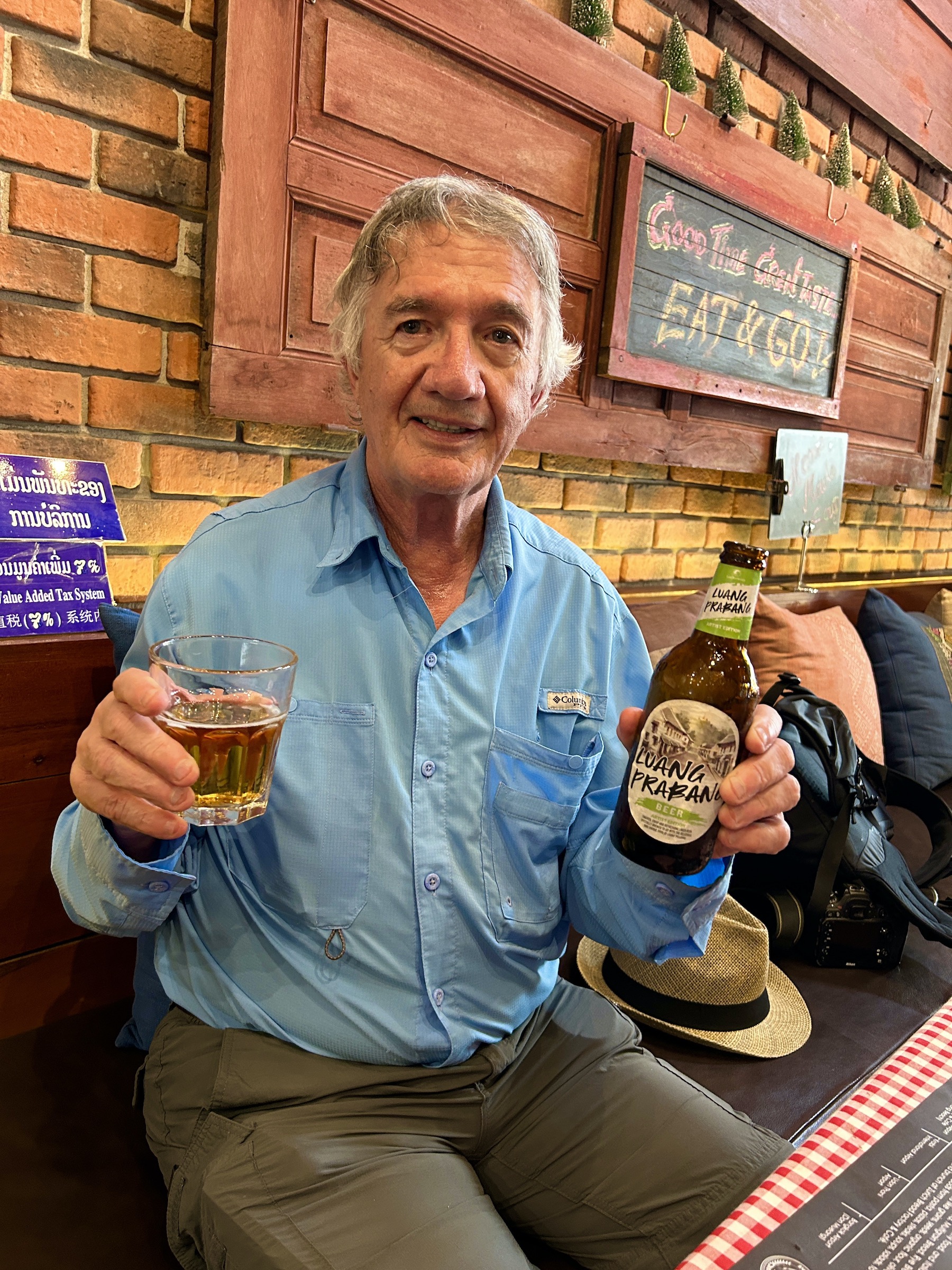
In any event it paired very well with an excellent Cuban sandwich. Alison had a humungous blt washed down with an iced latte. Should you be in Luang Prabang looking for something more western then I highly recommend this place.
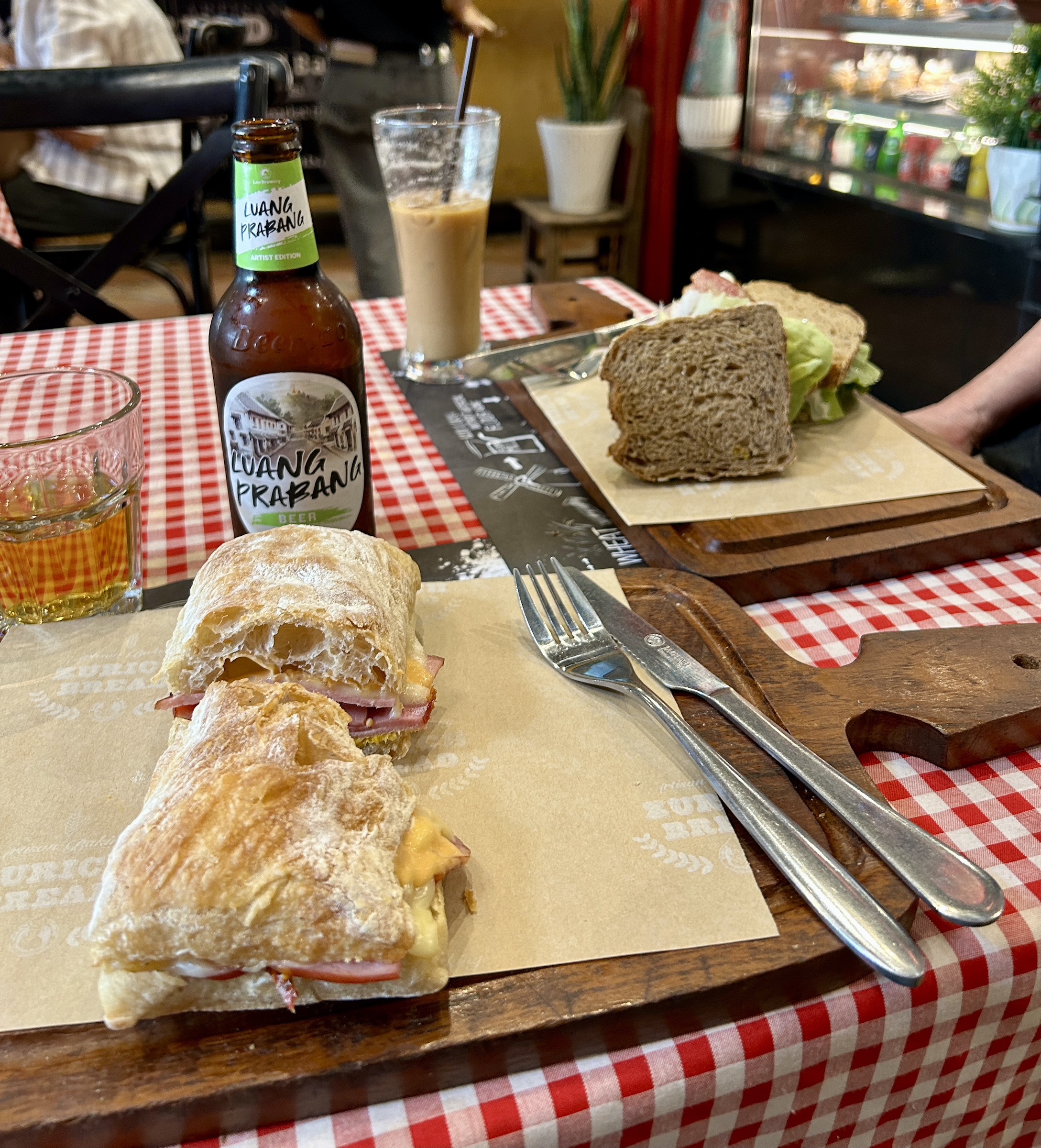
Refreshed and refueled we rejoined the group for our next and final stop of the day.
Wat Xieng Thong
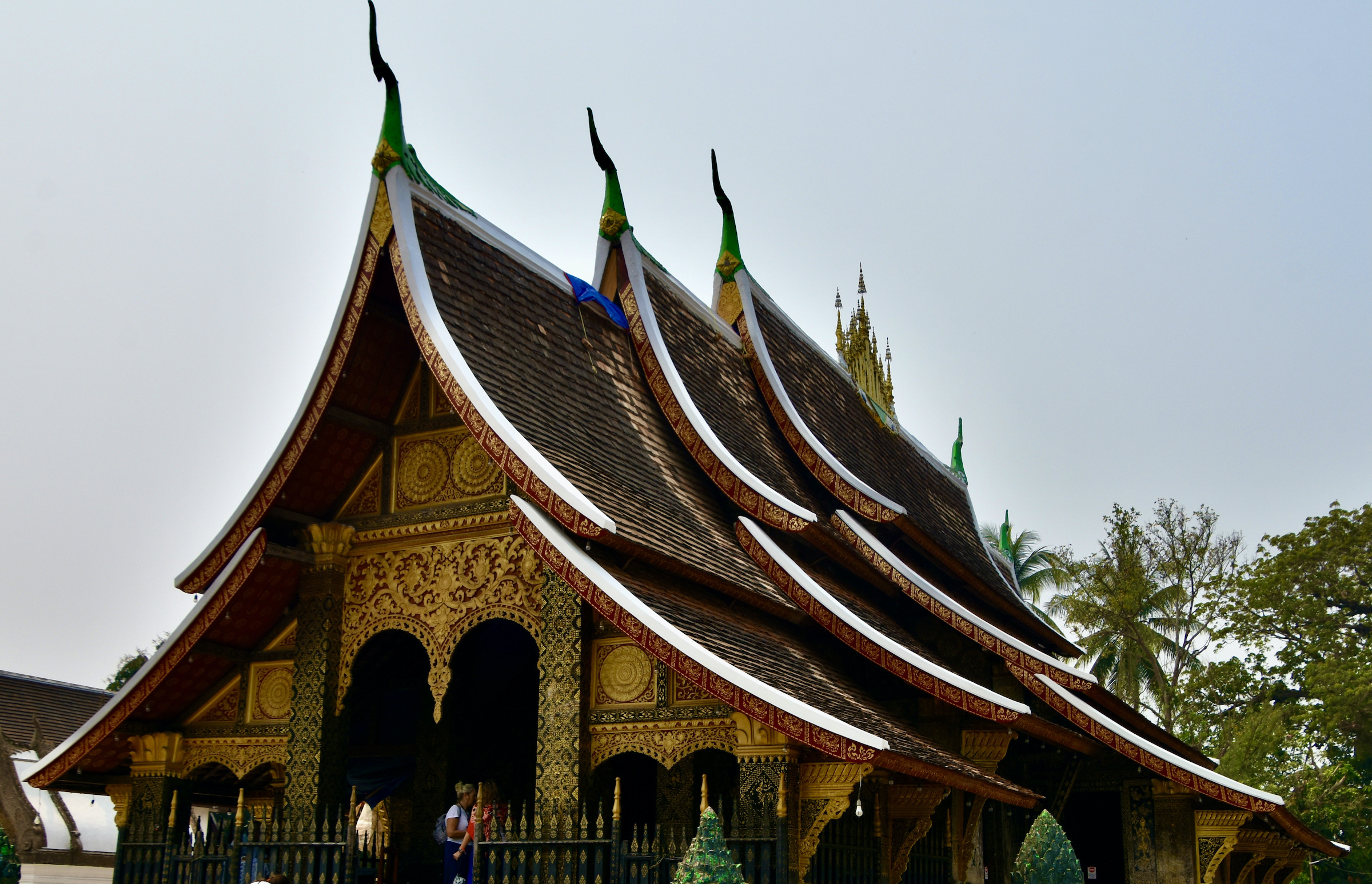
This temple complex retains the original name of the city and is considered the best example of traditional Luang Prabang architecture. Built in 1559-60 by King Setthathirath, it was spared destruction by the Chinese gangs that destroyed most of Luang Prabang’s temples in the late 1800s because one of their leaders had studied there as a monk. It has an amazing multi layer wooden roof topped by a unique finial design.
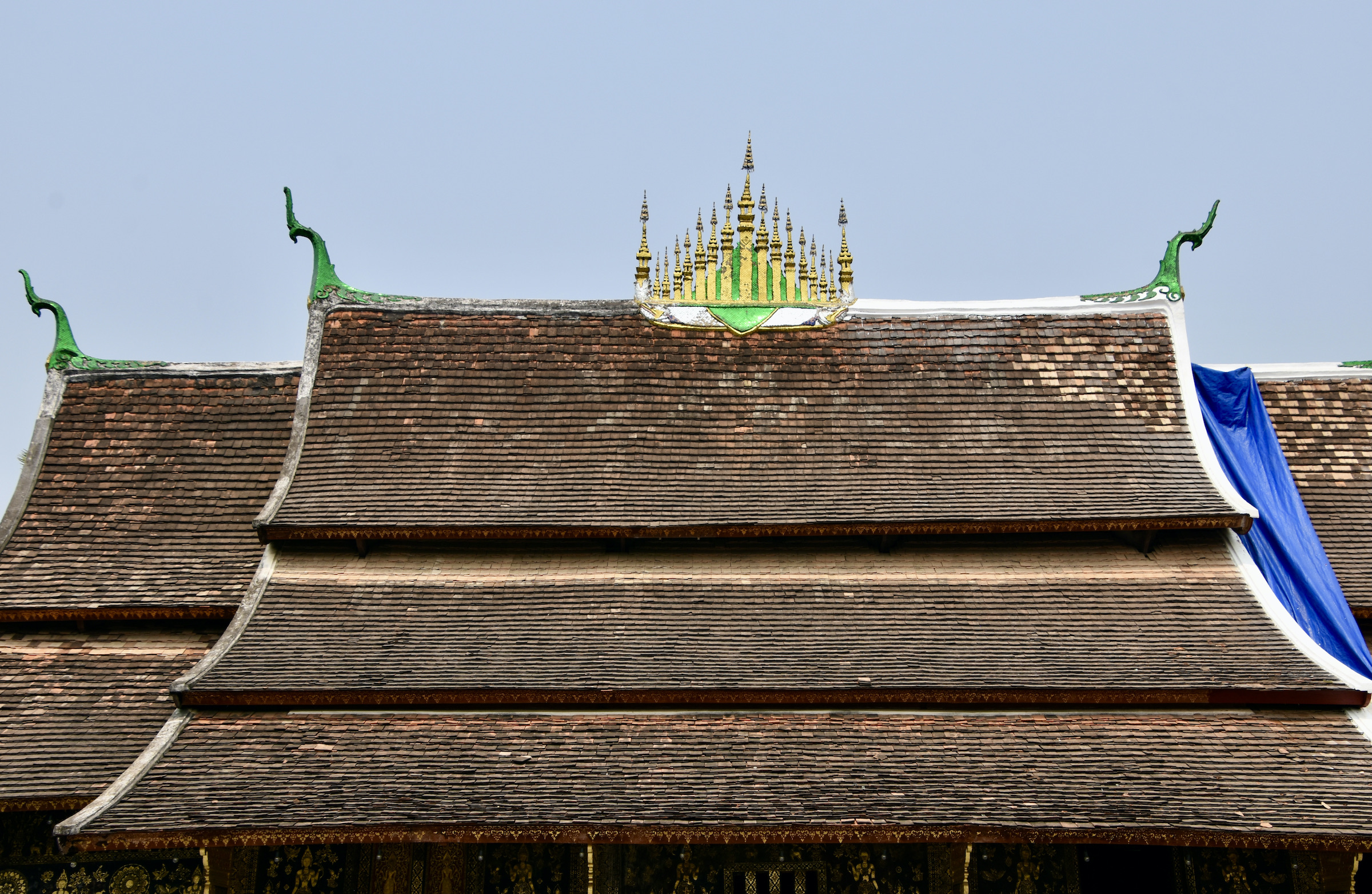
There are over twenty separate structures that make up the monastery including a library.

Note the mosaics on the outer walls. Here is the white elephant symbol once again, standing above scenes of traditional village life in Luang Prabang.
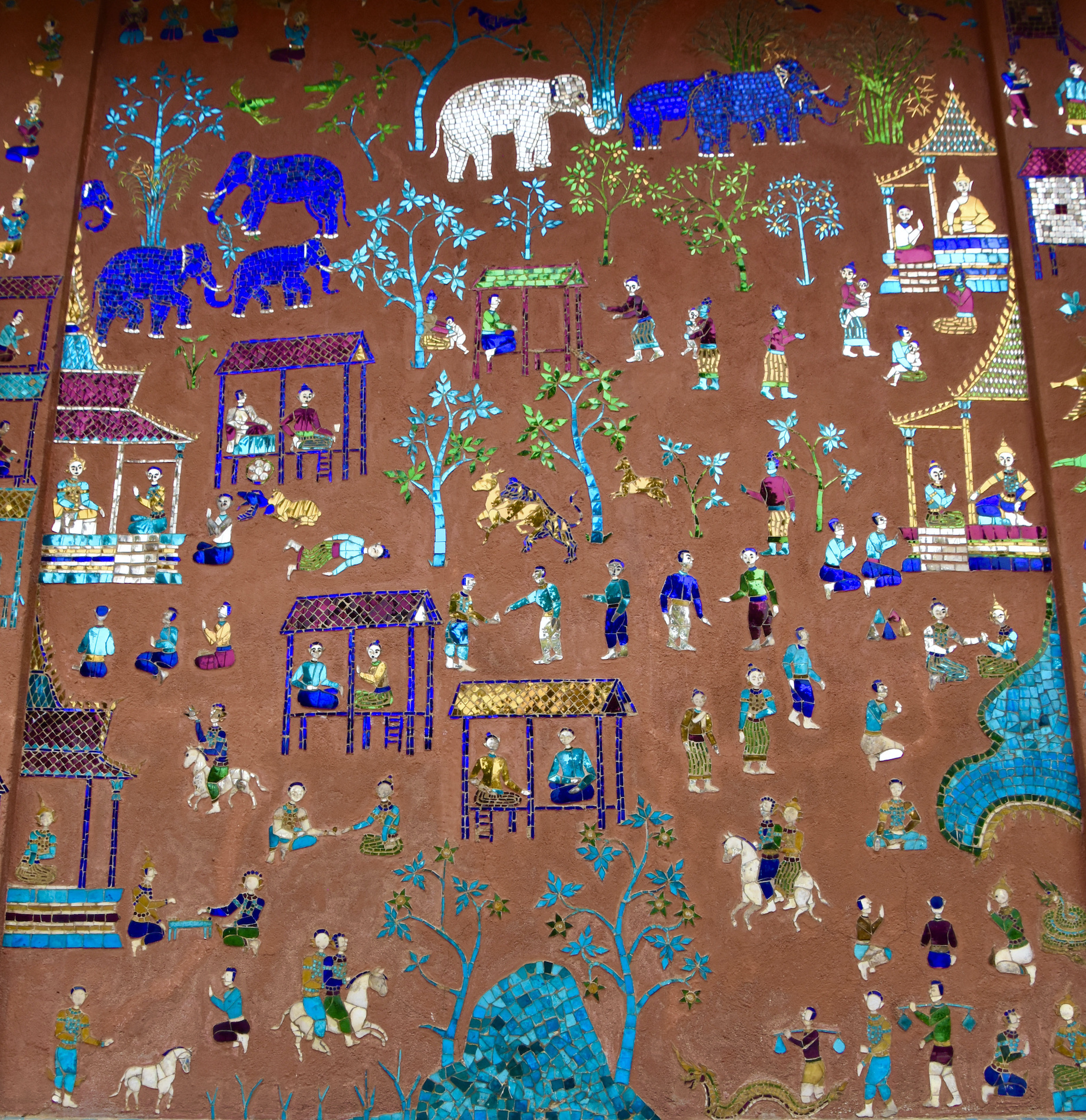
This is the Carriage House which was built to house the funerary carriage of King Sisavang Vong.
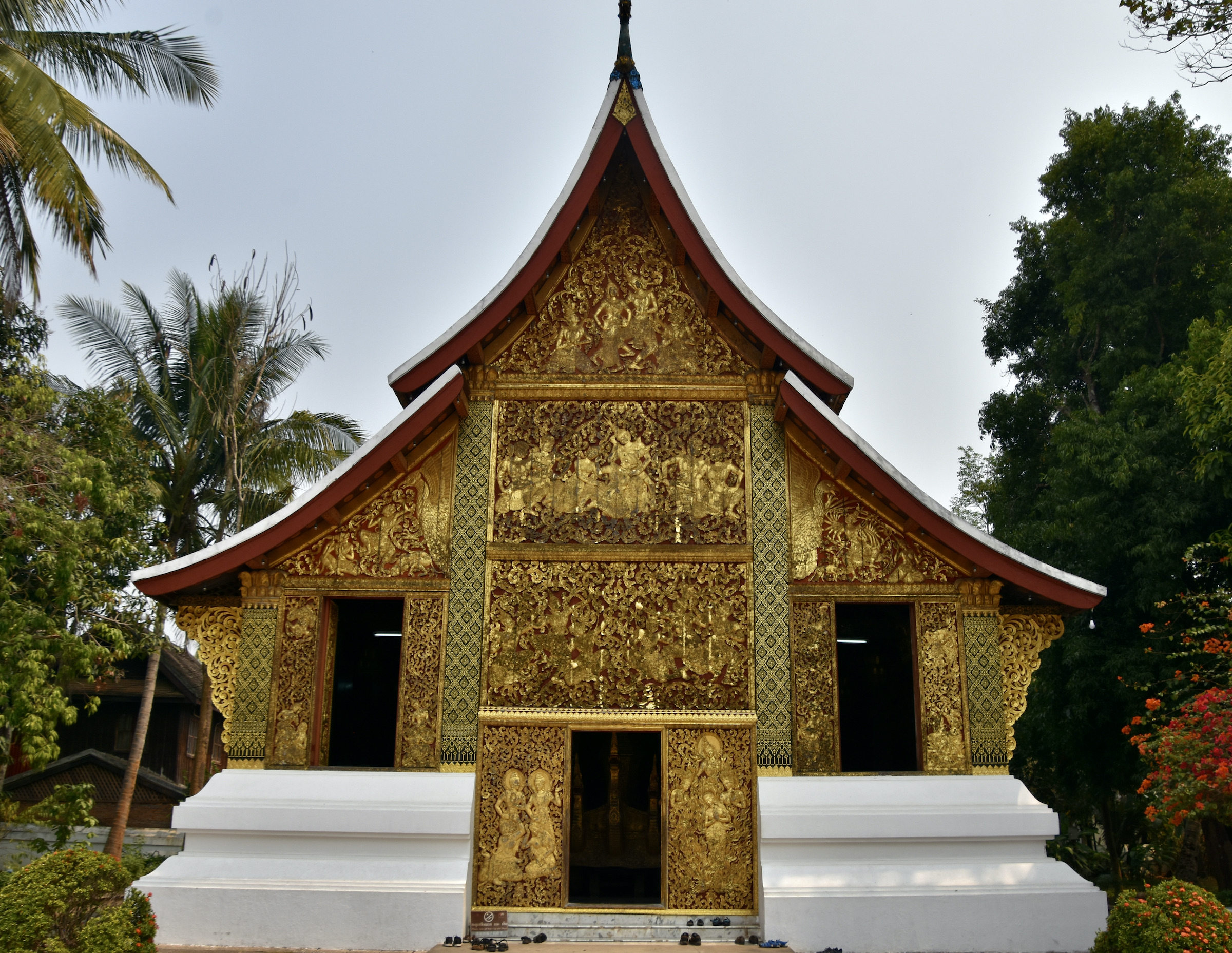
There are also a number of small stupas to admire.
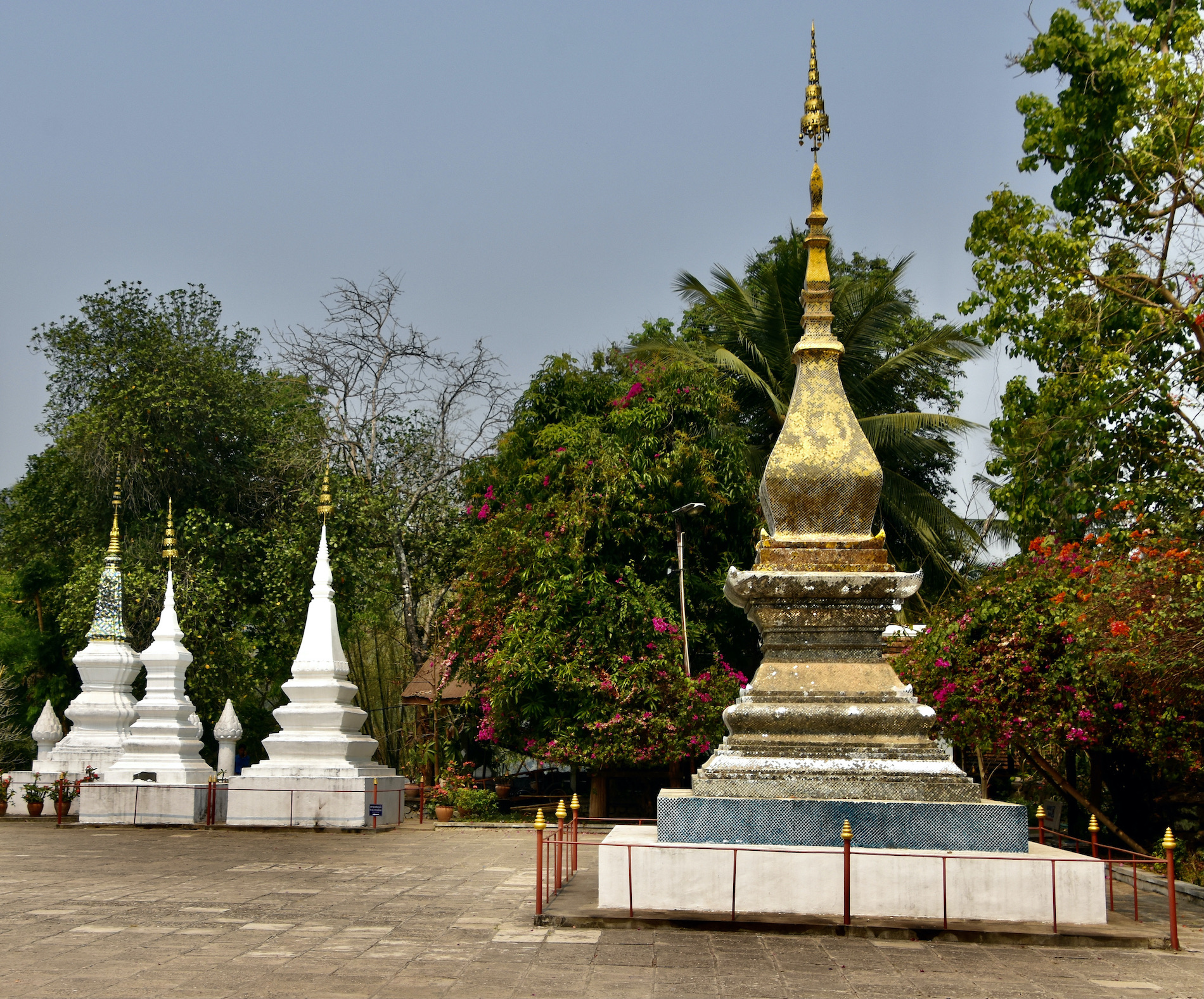
To me the most impressive sight of many at Wat Xieng Thong was this Tree of Life mosaic created only in 1960 by local artisans. Considering the chaos that enveloped the country from WWII right up until 1975 it is amazing that there was any creative spirit left in Laos, but clearly there was.
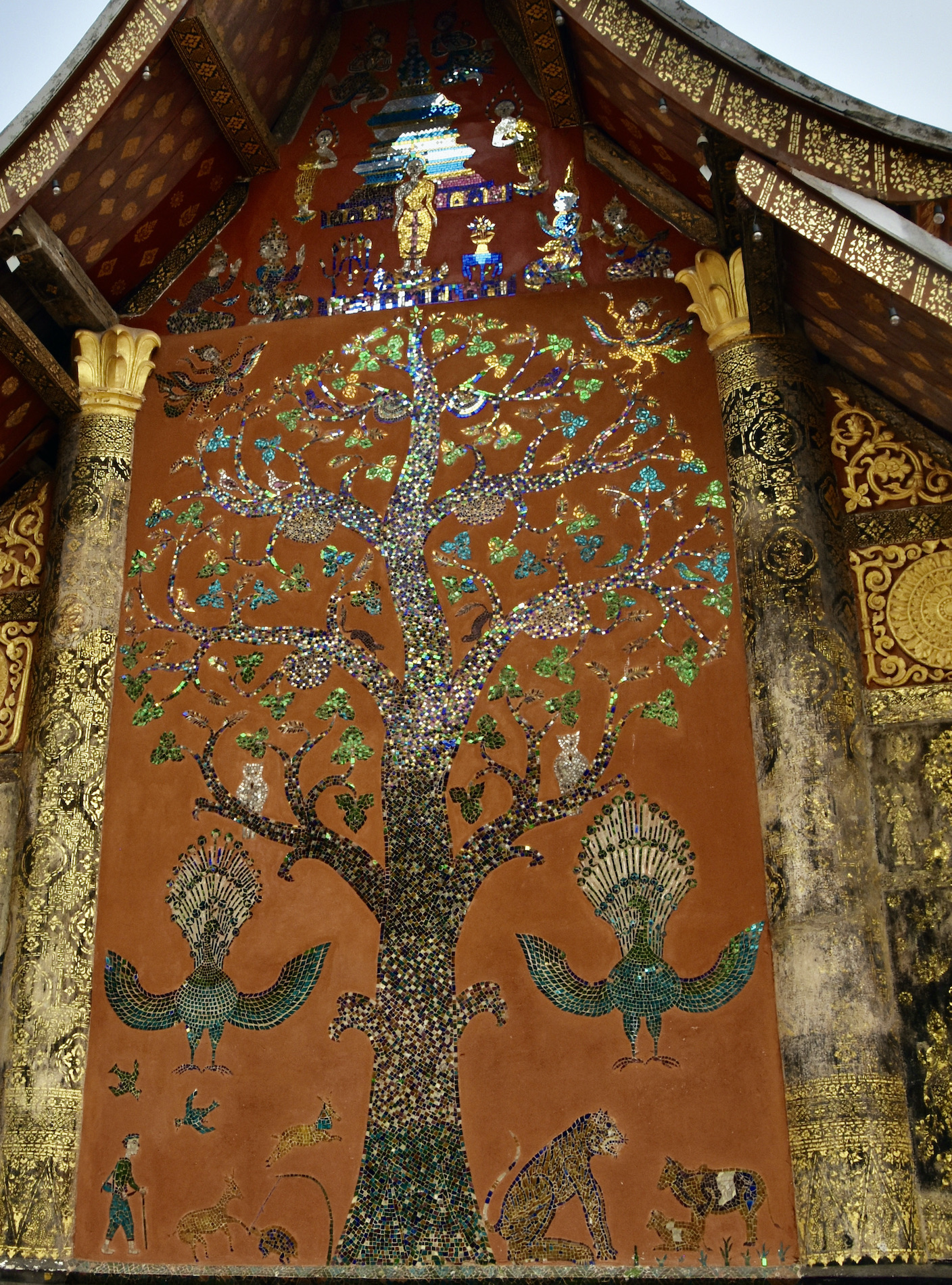
The Wat Xieng Thong was probably the most beautiful of the temples and monasteries we visited in Luang Prabang with a great location overlooking the Mekong and the buildings interspersed between gardens and specimen trees and thus a fitting place to end our tour of the temples.
That evening Claude took us to the Three Nagas restaurant which features traditional Lao cuisine in a very elegant setting.
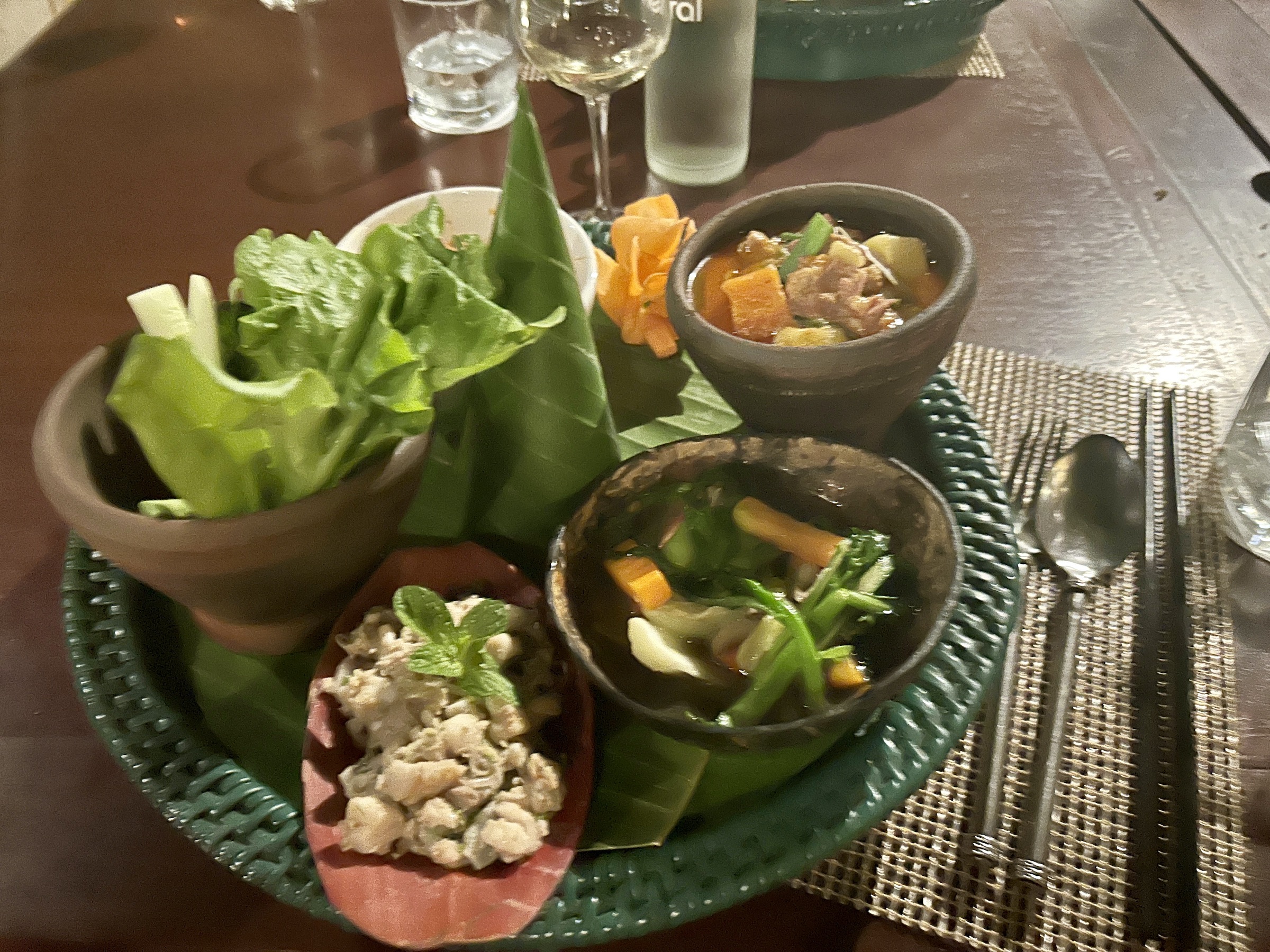
After the meal we visited the night market at our leisure and returned to the hotel after a very full day of exploring Luang Prabang. We will be getting up very early tomorrow to participate in an alms giving ceremony with local monks. I hope you’ll join us.

